
“DRAFT”
U.S. Department
of Transportation
Federal Aviation
Administration
Advisory
Circular
Subject: Minimum Equipment Requirements
for General Aviation Operations
Under 14 CFR Part 91, § 91.213
Date: DRAFT AC No: AC 91-67A
Initiated by: AFS-800 Change:
This advisory circular (AC) describes acceptable methods for the operation of aircraft with
certain inoperative instruments and equipment items, which are not essential for safe operations
under Title 14 of the Code of Federal Regulations (14 CFR) part 91, 133, or 137 (including
part 91 operations conducted by parts 141 and 142 certificate holders (CH)).
The contents of this document do not have the force and effect of law and are not meant to bind
the public in any way, and the document is intended only to provide information to the public
regarding existing requirements under the law or agency policies.
This AC describes an acceptable means, but not the only means, to operate an aircraft with
certain inoperative instruments and equipment items that are not essential. While using the
means described in this AC is not mandatory, an operator that voluntarily elects to use the means
described in this AC must follow, in all respects, the terms, conditions, and processes provided in
the AC.
Lawrence Fields
Acting Executive Director, Flight Standards Service

DATE “DRAFT” AC 91-67A
ii
CONTENTS
Paragraph Page
Chapter 1. Introduction ................................................................................................................ 1-1
1.1 Purpose of This Advisory Circular (AC) ...................................................................... 1-1
1.2 Audience ....................................................................................................................... 1-1
1.3 Where You Can Find This AC...................................................................................... 1-1
1.4 What This AC Cancels.................................................................................................. 1-1
1.5 Related 14 CFR Sections .............................................................................................. 1-2
1.6 Related Documents (current editions) .......................................................................... 1-2
1.7 Background ................................................................................................................... 1-2
1.8 Definitions and Terminology ........................................................................................ 1-3
1.9 AC Feedback Form ....................................................................................................... 1-8
Chapter 2. Master Minimum Equipment List (MMEL) .............................................................. 2-1
2.1 General ......................................................................................................................... 2-1
2.2 ATA/JASC Coded System Section Components ......................................................... 2-1
2.3 Obtaining a Current MMEL.......................................................................................... 2-3
2.4 Aircraft for Which No MMEL Has Been Developed ................................................... 2-3
2.5 MMEL PLs ................................................................................................................... 2-3
2.6 MMEL PL Global Change (GC) Designation .............................................................. 2-4
Chapter 3. Minimum Equipment List (MEL) .............................................................................. 3-1
3.1 General ......................................................................................................................... 3-1
3.2 Three Methods for Operating an Aircraft with Inoperative Equipment ....................... 3-2
3.3 MEL LOA ..................................................................................................................... 3-2
3.4 Aircraft Operated Under Multiple 14 CFR Parts .......................................................... 3-3
3.5 Fleet MEL ..................................................................................................................... 3-3
Chapter 4. Conducting Operations Without an MEL .................................................................. 4-1
4.1 Operating Without an MEL .......................................................................................... 4-1
4.2 Removal, Deactivation, and Placarding ........................................................................ 4-1
4.3 Continued Operation with Inoperative Items ................................................................ 4-2
4.4 Safety Risk Analysis of Proposed Operation with Inoperative Equipment Items ........ 4-3

DATE “DRAFT” AC 91-67A
iii
Chapter 5. Conducting Operations with an MEL ........................................................................ 5-1
5.1 Operating with an MEL ................................................................................................ 5-1
5.2 Documentation of Deferred Items ................................................................................ 5-2
5.3 Placarding ..................................................................................................................... 5-2
5.4 Performing (M) and (O) Procedures ............................................................................. 5-2
5.5 Repair of Deferred Instruments or Equipment Items .................................................... 5-3
Chapter 6. Application for MEL Letter of Authorization (LOA) ................................................ 6-1
6.1 Application for an MEL Approval Issued Under LOA D095 ...................................... 6-1
6.2 Application for an MEL Approval Issued Under LOA D195 ...................................... 6-1
6.3 Request for Approval of an MEL That Does Not Conform to This AC....................... 6-1
6.4 Oversight ....................................................................................................................... 6-1
Chapter 7. Content of a Procedures Document ............................................................................ 7-1
7.1 MEL Approval Under LOA D095 ................................................................................ 7-1
7.2 Procedures Document Content ..................................................................................... 7-1
7.3 Procedures Document Required Sections ..................................................................... 7-1
7.4 Procedures Document Optional Sections...................................................................... 7-3
7.5 Example “As Required by 14 CFR” and (M) and (O) Procedures ............................... 7-3
Chapter 8. Content of an Operator-Developed MEL ................................................................... 8-1
8.1 MEL Approval Under LOA D195 ................................................................................ 8-1
8.2 MEL Content ................................................................................................................ 8-1
8.3 MEL Required Sections ................................................................................................ 8-1
8.4 MEL Optional Sections................................................................................................. 8-2
8.5 ATA/JASC Coded System Sections ............................................................................. 8-2
8.6 Example Proviso, “As Required by 14 CFR,” and (M) and (O) Procedures ................ 8-7
Chapter 9. MEL Revisions ........................................................................................................... 9-1
9.1 General ......................................................................................................................... 9-1
9.2 FAA-Initiated MEL Revisions ...................................................................................... 9-1
9.3 Operator-Initiated MEL Revisions ............................................................................... 9-4
9.4 Vertical Bar (Change Bar) ............................................................................................ 9-4
Chapter 10. MEL Relief for Items Installed After Type Certification ....................................... 10-1
10.1 General ...................................................................................................................... 10-1

DATE “DRAFT” AC 91-67A
iv
10.2 Operator NEF Items or Administrative Control Items (ACI) ................................... 10-1
10.3 MMEL Items and MEL Items ................................................................................... 10-1
10.4 MMEL PL-109 .......................................................................................................... 10-1
10.5 STCs ....................................................................................................................... 10-1
10.6 Adding Relief for Items Installed After Type Certification ...................................... 10-2
10.7 Items Needed for Evaluation of Design Changes ..................................................... 10-3
Chapter 11. Nonessential Equipment and Furnishings (NEF) Program .................................... 11-1
11.1 Definition................................................................................................................... 11-1
11.2 Background ............................................................................................................... 11-1
11.3 The NEF Program Under § 91.213(a) ....................................................................... 11-1
11.4 Deferral Authority ..................................................................................................... 11-2
11.5 NEF Program Development ...................................................................................... 11-3
11.6 Required NEF Program Contents .............................................................................. 11-3
11.7 NEF Program Approval............................................................................................. 11-4
11.8 Criteria for Selection of NEF Items .......................................................................... 11-4
11.9 NEF Deferral Process ................................................................................................ 11-5
Chapter 12. Configuration Deviation List (CDL) ...................................................................... 12-1
12.1 Purpose of the CDL ................................................................................................... 12-1
12.2 Development ............................................................................................................. 12-1
12.3 CDL Versus MEL ..................................................................................................... 12-1
12.4 CDL Management Program ...................................................................................... 12-2
List of Figures
Figure 2-1. Example MMEL ATA/JASC Coded System Section Page .................................... 2-2
Figure 2-2. Sample Global Change Header Box ....................................................................... 2-4
Figure 4-1. PIC Decision Sequence ........................................................................................... 4-4
Figure 5-1. PIC Decision Sequence ........................................................................................... 5-4
Figure 6-1. Sample LOA D095 Request Letter ......................................................................... 6-2
Figure 6-2. Sample LOA D195 Request Letter for an Operator-Developed MEL That Conforms
to the Content Described in AC 91-67 .................................................................... 6-3
Figure 6-3. Sample LOA D195 Request Letter for an Operator-Developed MEL That Does Not
Conform to the Content Described in AC 91-67 .................................................... 6-4
Figure 7-1(a). Example MMEL “As Required by 14 CFR” Statement ...................................... 7-3

DATE “DRAFT” AC 91-67A
v
Figure 7-1(b). Example Procedures Document “As Required by 14 CFR” Regulatory
Reference or Requirement/Limitation ................................................................. 7-4
Figure 7-2(a). Example 1 MMEL Maintenance (M) and Operations (O) Symbols and
Provisos ................................................................................................................ 7-4
Figure 7-2(b). Example 1 Procedures Document Maintenance (M) and Operations (O)
Procedures ............................................................................................................ 7-4
Figure 7-3(a). Example 2 MMEL Maintenance (M) Symbol and Proviso ................................. 7-5
Figure 7-3(b). Example 2 Procedures Document Maintenance (M) Procedure .......................... 7-5
Figure 8-1(a). Example MMEL General “As Required by 14 CFR” Statement ........................ 8-8
Figure 8-1(b). Example MEL Specific “As Required by 14 CFR” Regulatory Reference......... 8-8
Figure 8-1(c). Example MEL Specific “As Required by 14 CFR” Requirement/Limitation ..... 8-9
Figure 8-2(a). Example 1 MMEL General Maintenance (M) and Operations (O) Symbols
and Provisos ......................................................................................................... 8-9
Figure 8-2(b). Example 1 MEL Specific Maintenance (M) and Operations (O) Symbols
and Provisos ....................................................................................................... 8-10
Figure 8-2(c). Example 1 Procedures Document Maintenance (M) and Operations (O)
Procedures .......................................................................................................... 8-10
Figure 8-3(a). Example 2 MMEL General Maintenance (M) Symbol and Proviso ................. 8-11
Figure 8-3(b). Example 2 MEL Specific Maintenance (M) Symbol and Proviso .................... 8-11
Figure 8-3(c). Example 2 Procedures Document Maintenance (M) Procedure ........................ 8-12
Figure 8-4(a). Example 3 MMEL General Operation (O) Symbol and Proviso ....................... 8-12
Figure 8-4(b). Example 3 MEL Specific Operations (O) Symbol and Proviso ........................ 8-12
Figure 8-4(c). Example 3 Procedures Document Operations (O) Procedure ............................ 8-13
Figure 11-1. Required NEF MEL Proviso for an Operator’s NEF Program .......................... 11-4
Figure 11-2. NEF Item Selection Criteria Elements Flowchart ............................................. 11-7

DATE “DRAFT” AC 91-67A
1-1
CHAPTER 1. INTRODUCTION
1.1 Purpose of This Advisory Circular (AC). This AC describes acceptable ways in which
an aircraft can be operated under Title 14 of the Code of Federal Regulations (14 CFR)
part 91, 133, or 137 (including part 91 operations conducted by parts 141 and 142
certificate holders (CH)) with certain inoperative instruments and equipment items that
are not essential for safe operations, in accordance with part 91, § 91.213. The methods
described are not the only means to comply with § 91.213. The Federal Aviation
Administration (FAA) will consider other means of compliance an operator may present.
1.1.1 Effects of Guidance. The contents of this document do not have the force and effect of
law and are not meant to bind the public in any way, and the document is intended only
to provide information to the public regarding existing requirements under the law or
agency policies. While using the means of compliance described in this AC is not
mandatory, an operator that voluntarily elects to use the means of compliance described
in this AC must follow, in all respects, the terms, conditions, and processes described in
the AC. The use of terms such as “shall” and “must” throughout the AC do not impose
any regulatory requirement.
1.2 Audience. This AC applies only to aircraft operated under parts 91, 133, and 137
(including part 91 operations conducted by parts 141 and 142 CHs) with certain
inoperative instruments and equipment.
Note: Unless otherwise stated, the term “operator,” used throughout this AC,
applies to part 91 operators, parts 133 and 137 CHs, and part 141 pilot schools or
provisional pilot schools. This AC uses the singular term “operator” for
simplicity.
1.2.1 Applicability. This AC does not apply to part 91 subpart K (part 91K) program managers
or CHs under 14 CFR part 121, 125 (including part 125 Letter of Deviation Authority
(LODA) holders), or 135. These operators are required to comply with their approved
minimum equipment list (MEL), even when the operation is conducted under part 91.
Refer to § 91.213(c).
1.2.2 Foreign Air Carriers and Foreign Operators of U.S. Registered Aircraft Engaged in
Common Carriage (14 CFR Part 129). Foreign air carriers and foreign operators of U.S.
registered aircraft engaged in common carriage should refer to AC 129-4, Maintenance
Programs for U.S. Registered Aircraft Operated Under 14 CFR Part 129, for information
regarding their MELs.
1.3 Where You Can Find This AC. You can find this AC on the FAA’s website at
https://www.faa.gov/regulations_policies/advisory_circulars and the Dynamic Regulatory
System (DRS) at https://drs.faa.gov.
1.4 What This AC Cancels. AC 91-67, Minimum Equipment Requirements for General
Aviation Operations Under FAR Part 91, dated June 18, 1991, was canceled on
November 3, 2017.

DATE “DRAFT” AC 91-67A
1-2
1.5 Related 14 CFR Sections. All regulatory references in this AC are found in 14 CFR
unless otherwise indicated. The following 14 CFR sections are related to this AC. You
can download the full text of these regulations at the U.S. Government Publishing Office
(GPO) Electronic Code of Federal Regulations (e-CFR) website at https://ecfr.gov. You
can order a paper copy by sending a request to the U.S. Superintendent of Documents,
U.S. Government Publishing Office; by calling the telephone number 202-512-1800; or
by sending a request by facsimile at 202-512-2104.
• Part 21, §§ 21.19, 21.197, and 21.199.
• Part 43, §§ 43.3, 43.7, 43.9, 43.11, and 43.13.
• Part 91, §§ 91.7, 91.205, 91.213, 91.405, 91.417, and 91.501.
1.6 Related Documents (current editions).
• Master Minimum Equipment List (MMEL) Policy Letter (PL)-25, MMEL/MEL
Definitions.
• MMEL PL-36, 14 CFR Part 91 MEL Approval and Preamble.
• AC 43-9, Maintenance Records.
• AC 43-12, Preventive Maintenance.
• AC 91-70, Oceanic and Remote Continental Airspace Operations.
1.7 Background. The airworthiness certification of an aircraft is conditioned on the aircraft
conforming to its type certificate (TC) and being in a condition for safe operation. While
items installed in an aircraft must be operative for the aircraft to conform to its TC, an
approved MEL allows an operator to operate the aircraft with certain items inoperative.
An approved MEL, as authorized by a Letter of Authorization (LOA) under § 91.213(a),
constitutes an approved change to the type design without requiring recertification.
1.7.1 Airworthiness. Under § 91.7, an operator cannot operate an aircraft unless it is in an
airworthy condition. As noted above, to be airworthy, the aircraft must conform to its TC
and be in a condition for safe operation. An inoperative item present on the aircraft would
result in a violation of § 91.7, unless the inoperative item or equipment is listed on the
operator’s approved MEL, in accordance with § 91.213. As such, compliance with all
applicable criteria of an MEL is necessary when taking advantage of the relief an MEL
provides; in the absence of such compliance, the FAA would not consider the aircraft
airworthy.
1.7.2 Acceptable Level of Safety (ALoS). The FAA developed the concept of the MEL after
recognizing that under certain circumstances, a flight or series of flights might occur
safely with certain inoperable instruments and equipment. In certain specific situations,
an ALoS can be met because not all of an aircraft’s installed instruments and equipment
are necessary for every type of operation. For example, a flight that is not being
conducted in icing conditions would not require operable airframe deicing or anti-icing
equipment. Similarly, an aircraft that will not operate at night may receive relief from the

DATE “DRAFT” AC 91-67A
1-3
requirement to have an operable landing light. In other words, the MEL requirements and
related processes are independent from an aircraft’s operating requirements and an MEL
cannot authorize a deviation from operating rules.
1.7.3 Requirement for Items to be Operative. All items related to the airworthiness of the
aircraft that are not included in an approved MEL are required to be operative in
accordance with the aircraft’s TC. An MEL does not include obviously required items,
such as wings, rudders, flaps, engines, landing gear, etc. An aircraft is not airworthy
when any item that is not included in the MEL is inoperative.
1.7.4 Repair Inoperative Items at Earliest Opportunity. The MEL is intended to permit
operations with inoperative items of equipment for the minimum period of time necessary
until repairs can be accomplished. It is important that repairs be accomplished at the
earliest opportunity to return the aircraft to its design level of safety and reliability.
1.7.5 MEL Development. The MEL is developed from an MMEL for the aircraft type. The
operator uses the MMEL as the baseline to develop the MEL and the operational and
maintenance procedures and lists the items installed in the operator’s aircraft. The MEL
is developed by the operator for their particular type of operation (i.e., instrument flight
rules (IFR), visual flight rules (VFR), Category (CAT) II, over water, etc.). The MEL is
approved by the responsible Flight Standards office.
1.8 Definitions and Terminology. For additional MMEL and MEL definitions, refer to
MMEL PL-25.
1.8.1 Airworthiness Directive (AD). ADs are legally enforceable regulations issued by the
FAA in accordance with 14 CFR part 39 to correct an unsafe condition in a product.
Part 39 defines a product as an aircraft, engine, propeller, or appliance.
1.8.2 Air Transport Association of America (ATA)/Joint Aircraft System/Component (JASC)
Coded System Section Components. MMEL system sections are organized by aircraft
system according to the ATA or JASC coded numbering system. MMEL system numbers
use the ATA/JASC codes that are standardized for each aircraft system. The ATA/JASC
numbering system provides an industrywide standard for numbering aircraft systems and
is relevant for all aircraft. ATA changed its name to Airlines for America (A4A) in 2011;
however, the acronym “ATA” is still used for coded aircraft systems. The acronyms
“ATA” and “A4A” are considered interchangeable. The alternate format for aircraft
system coding is the JASC codes, which are a modified version of the ATA codes.
1.8.3 Aircraft Evaluation Division (AED). The inspectors in AED serve as technical subject
matter experts for operational and engineering activities of the FAA’s Flight Standards
Service (FS). These inspectors coordinate and assist with aircraft certification and
continued airworthiness programs and serve as a liaison with the responsible Aircraft
Certification Service office during the initial certification of an aircraft and throughout
the service life of the aircraft.
1.8.4 Configuration Deviation List (CDL). A CDL is a list of externally exposed aircraft parts
that may be missing for flight. A CDL allows continued operation with missing

DATE “DRAFT” AC 91-67A
1-4
externally exposed nonstructural parts by defining restrictions, limitations, or
performance penalties, while the aircraft remains airworthy. See Chapter 12 for
additional information on the CDL.
1.8.5 Deferral. The term “deferral” is used to describe the authorization for an operator to delay
repair and continue operating with a required item inoperative, under the authority of
their FAA-approved MEL. Authority to defer an inoperative item is subject to specific
conditions and limitations, as described in the associated proviso.
1.8.6 Dynamic Regulatory System (DRS). DRS is an FAA website that contains regulatory,
policy, and guidance information. DRS can be accessed at https://drs.faa.gov.
1.8.7 Flight Operations Evaluation Board (FOEB). An FOEB is comprised of technically
qualified specialists, engineering representatives, and aviation safety inspectors (ASI)
responsible for developing MMELs from the proposed MMEL provided by the aircraft
manufacturer. An aircraft MMEL is usually developed during initial aircraft certification.
FOEBs are also responsible for developing MMEL revisions. FOEBs coordinate with
internal and external stakeholders, such as the responsible Aircraft Certification Service
office, Flight Standards offices, aircraft and engine manufacturers, operators, and
private-sector groups.
1.8.8 Global Change (GC). A GC is newly developed or changed relief for an item, usually
applicable to numerous MMELs (hence “global”) to allow operators to obtain MEL relief
prior to the release of a revised MMEL. Incorporation of a GC into an operator’s MEL is
optional until the GC is incorporated in the aircraft’s MMEL. GCs may be used to
provide immediate relief for items required by a new regulatory requirement, policy
change, or new technology.
1.8.9 Kinds of Operations Equipment List (KOEL). Aircraft certificated under 14 CFR part 23
or 27 may have a KOEL. The KOEL specifies the kinds of operations (e.g., VFR, IFR,
day, or night) in which the aircraft can be operated. The KOEL also indicates the
installed equipment that may affect any operating limitation. Although the certification
rules require this information, there is no standard format; consequently, the
manufacturer may furnish it in various ways. Inoperative equipment, when required by
the KOEL for a particular type of operation (e.g., VFR, IFR, day, or night), may not be
deferred for that operation under § 91.213.
1.8.10 Letter of Authorization (LOA). The term “LOA,” used throughout this AC, refers to an
operator-specific LOA, which is the MEL-authorizing document containing conditions
and limitations the operator must comply with in order to conduct aircraft operations with
specific inoperative items. When used in this AC, the term “LOA” refers to all LOAs
issued under the provisions of § 91.213(a) to part 91 operators, part 133 rotorcraft
external-load operators, part 137 agricultural aircraft operators, and part 141 pilot schools
or provisional pilot schools.
Note: The part 142 training specification (TSpec) D095 has been
decommissioned. Part 142 training centers holding TSpec A003, Aircraft

DATE “DRAFT” AC 91-67A
1-5
Authorization, and seeking MEL authorization must do so under the appropriate
operating rule (e.g., part 91, 121, or 135).
1.8.11 Maintenance (M) Procedure. The (M) symbol indicates a specific maintenance procedure
that must be accomplished prior to operation with the listed item inoperative. Normally,
(M) procedures are accomplished by qualified maintenance personnel; however, other
personnel may be qualified and authorized to perform certain functions. Procedures
requiring specialized knowledge or skill, or requiring the use of tools or test equipment,
should be accomplished by maintenance personnel. The satisfactory accomplishment of
all (M) procedures, regardless of who performs them, is the responsibility of the aircraft
operator. Appropriate procedures are required as a part of the aircraft operator’s MEL.
See paragraph 5.4, Performing (M) and (O) Procedures.
1.8.12 Master Minimum Equipment List (MMEL).
1.8.12.1 The term “MMEL,” used throughout this AC, means an FAA-approved,
aircraft make, model, and series (M/M/S)-specific master list of aircraft
instrument and equipment items that may be inoperative under certain
operational conditions, while maintaining the airworthiness of the aircraft and
providing an ALoS. An MMEL is the baseline document used by operators to
develop their own aircraft-specific MEL. Operators may download MMELs
from the “MMELs and AED Guidance Documents” section in DRS at
https://drs.faa.gov.
1.8.12.2 The United States may enter a Bilateral Aviation Safety Agreement (BASA)
with a foreign government when there is a need for technical cooperation with
the foreign government’s Civil Aviation Authority (CAA), and if the foreign
authority’s civil aviation safety oversight is substantially comparable to the
FAA’s. BASAs are carried out through associated implementation procedures.
Refer to country-specific BASAs for MMEL considerations relating to foreign
type-certificated aircraft validated under Implementation Procedures for
Airworthiness (IPA). The BASAs and associated IPAs may be found at
https://www.faa.gov/aircraft/air_cert/international/bilateral_agreements/.
1.8.13 Minimum Equipment List (MEL). The term “MEL,” used throughout this AC, means a
document listing items that may be inoperative during flight for a specific aircraft or a
fleet of aircraft. Operation of the aircraft under the MEL is authorized by an operator
specific LOA. As provided in § 91.213(a)(2), an MEL and the associated LOA constitute
a Supplemental Type Certificate (STC) for the aircraft. Operators will base their MEL on
the MMEL applicable to the aircraft M/M/S. An operator’s MEL may be more restrictive
than the MMEL, but it will not be less restrictive. Unless specified otherwise, the term
“MEL,” used throughout this AC, refers to both: (1) the MEL approval under LOA D095,
MMEL Used as an MEL, consisting of an MMEL and a procedures document, and (2)
the MEL approval under LOA D195, Minimum Equipment List (MEL), consisting of an
operator-developed MEL. When required for clarity, this AC will distinguish between an
MEL approval under LOA D095 or D195 by using the terms “procedures document,” or
“operator-developed MEL,” respectively.

DATE “DRAFT” AC 91-67A
1-6
Note: MEL approvals under LOA D095 meet the International Civil Aviation
Organization (ICAO) MEL requirements of Annex 6, Parts II and III. However,
some CAAs may not accept LOA D095 as a valid MEL approval.
1.8.14 MMEL Policy Letters (PL). PLs clarify FAA MMEL policy regarding specific kinds of
equipment that may be deferred. While developing its MEL, an operator may need to
refer to one or more aircraft or equipment-specific PLs with a GC designation, as these
PLs may provide additional relief for items until the MMEL is revised. Operators may
download PLs from the “MMELs and AED Guidance Documents” section in DRS at
https://drs.faa.gov.
1.8.15 Make, Model, and Series (M/M/S). M/M/S is a common abbreviation used when
referring to a manufacturer’s particular model or type and series of given aircraft.
1.8.16 Nonessential Equipment and Furnishings (NEF) Program. An operator’s MEL program
may also include an NEF program that allows relief for nonessential items. An NEF
program allows operators to use the authority granted by their MEL LOA to provide
relief for nonessential items located throughout the aircraft. See Chapter 11 for additional
information on an NEF program.
1.8.17 Operational Control. As defined in 14 CFR part 1, § 1.1, operational control, “with
respect to a flight, means the exercise of authority over initiating, conducting or
terminating a flight.”
1.8.18 Operations (O) Procedure. The (O) symbol indicates a specific operations procedure that
must be accomplished prior to operation with the listed item inoperative. Normally, these
procedures are accomplished by the flightcrew; however, other personnel may be
qualified and authorized to perform certain functions. These procedures may be required
for flight planning purposes, or they may require action by the flightcrew. Additionally,
MEL items affecting the aircraft Weight and Balance (W&B) and cargo loading may
require procedures for additional personnel, such as those involved with aircraft load
control. The satisfactory accomplishment of all (O) procedures, regardless of who
performs them, is the responsibility of the aircraft operator. Appropriate procedures are
required as a part of the aircraft operator’s MEL. See paragraph 5.4.
1.8.19 Procedures Document. The procedures document is based on the MMEL applicable to
the aircraft M/M/S. The procedures document, the MMEL, and the MEL LOA D095
together constitute an approved MEL. The procedures document contains:
• The name(s) of the operator(s),
• The aircraft serial and registration numbers (or “Fleet”),
• The aircraft M/M/S,
• The MMEL revision number on which the MEL is based,
• (M) and (O) procedures that correspond with the (M) and (O) provisos listed in the
MMEL,

DATE “DRAFT” AC 91-67A
1-7
• A list of all MMEL items that contain the statement “as required by 14 CFR,”
• All applicable definitions, per MMEL PL-25, and
• The preamble, per current MMEL PL-36.
1.8.20 Principal Base of Operations. The term “principal base of operations” used throughout
this AC is the physical address where an operator or pilot school conducts business or
resides. It is a physical location where the FAA can contact the operator (i.e., a post
office box is not an acceptable principal base of operations). While the principal base of
operations may coincide with the place where the aircraft is located, this is not always the
case. Depending upon the applicable 14 CFR part, this location may be an operator’s
residence, business address, home base of operations, or a pilot school’s principal
business office. For simplicity, this AC uses the singular term “principal base of
operations” to refer to all these locations.
1.8.21 Principal Inspector (PI). PIs are FAA personnel, within the operator’s responsible Flight
Standards office, who are assigned primary responsibility for oversight of an operator’s
safety of operations. PIs specialize in the three general areas of aircraft operations
according to their qualifications, either as a Principal Avionics Inspector (PAI), Principal
Maintenance Inspector (PMI), or Principal Operations Inspector (POI). PIs have FAA
administrative authority to evaluate and approve an operator’s manuals, including the
MEL.
1.8.22 Responsible Flight Standards Office. The term “responsible Flight Standards office,”
used throughout this AC, refers to the Flight Standards office responsible for issuance
and oversight of all LOAs for the operator. This is typically the Flight Standards office
with a Service Area (SA) covering the location of the operator’s principal base of
operations. FAA office locations are available at
https://www.faa.gov/about/office_org/field_offices/fsdo/ and
https://www.faa.gov/about/office_org/field_offices/ifo.
1.8.23 Responsible Person (Part 91 Only). The term “Responsible Person,” used throughout this
AC, is the person who has legal authority to sign the LOA on behalf of a part 91 operator.
Such person should have ongoing knowledge of the operations of the aircraft. The
Responsible Person may be the individual who acts as operator or, if the operator is a
legal entity, an officer, employee, or person duly designated to act on behalf of the
operator. The person assumes responsibility for ensuring the operator complies with all
applicable regulations, requirements, limitations, and provisions. If the Responsible
Person relinquishes responsibility, the LOA is no longer valid.
1.8.24 Supplemental Type Certificate (STC). An STC is a TC issued by the FAA to a person
who applies for a major change to a type design when the proposed change does not
require an application for a new TC under § 21.19. The STC, which incorporates by
reference the related TC, approves not only the modification but also how that
modification affects the original design.

DATE “DRAFT” AC 91-67A
1-8
1.9 AC Feedback Form. For your convenience, the AC Feedback Form is the last page of
this AC. Note any deficiencies found, clarifications needed, or suggested improvements
regarding the contents of this AC on the Feedback Form.

DATE “DRAFT” AC 91-67A
2-1
CHAPTER 2. MASTER MINIMUM EQUIPMENT LIST (MMEL)
2.1 General.
2.1.1 MEL Is Based on an MMEL. An M/M/S-specific MMEL is the document on which an
operator will base their aircraft-specific MEL. MMELs are developed for most FAA
type-certificated aircraft in general service today. Most multiengine airplanes have an
MMEL specific to their type design (e.g., Mitsubishi MU-2B).
2.1.2 Generic Single Engine Airplane MMEL. The FOEB has developed a generic
single-engine airplane MMEL for single-engine airplanes that do not have an
M/M/S-specific MMEL. The generic single-engine airplane MMEL cannot be used for an
airplane that has its own M/M/S-specific MMEL. If an operator is using the generic
single-engine airplane MMEL, and an MMEL is subsequently published for that specific
make and model single-engine airplane, the operator’s MEL must be revised to conform
to the new M/M/S-specific MMEL within 90 calendar-days of new M/M/S-specific
MMEL publication.
Note: Operators base their MEL on the MMEL applicable to the aircraft M/M/S
or the generic single-engine airplane MMEL, as appropriate.
2.1.3 Items Listed in an MMEL. The MMEL includes those items of equipment related to
airworthiness and operating regulations and other items of equipment, which may be
inoperative, and yet maintain an ALoS by appropriate conditions and limitations; it does
not contain obviously required items, such as wings and rudders. Additionally, an MMEL
does not include items required to be operative by an AD, unless the AD specifically
allows for their inclusion.
2.2 ATA/JASC Coded System Section Components. These sections are organized by
aircraft system according to the ATA or JASC coded numbering system (see Figure 2-1,
Example MMEL ATA/JASC Coded System Section Page) and contain the following
components:
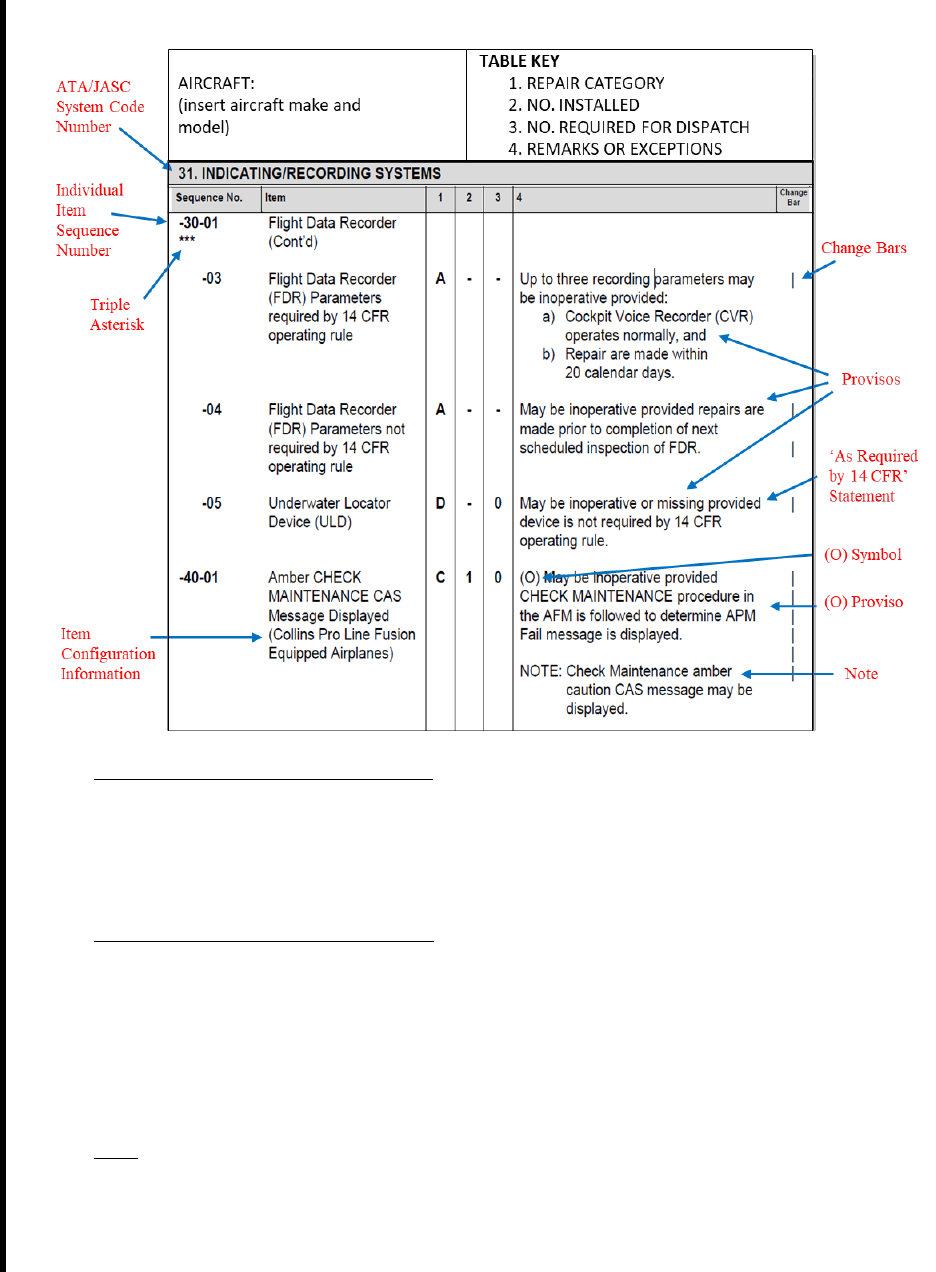
DATE “DRAFT” AC 91-67A
2-2
Figure 2-1. Example MMEL ATA/JASC Coded System Section Page
2.2.1 ATA/JASC System Code Numbers. MMEL system numbers use the ATA or JASC codes
that are standardized for each aircraft system. The ATA numbering system provides an
industrywide standard for numbering aircraft systems and is relevant for all aircraft. The
alternate format for aircraft system coding is the JASC codes, which are a modified
version of the ATA codes.
2.2.2 Individual Item Sequence Numbers. Individual item sequence numbers are the unique
identification for each item within an ATA/JASC system category. The numbering
scheme may be modified to align with the aircraft operator’s specific MEL format and
may differ from the MMEL. They are not required to match ATA/JASC system code
numbers. A triple asterisk (***) below the sequence number in the first column of an
MMEL indicates that an item, which is not required by regulation, has been installed on
some models of a particular aircraft.
2.2.3 Item. An item is an instrument, piece of equipment, a system, component, or function of
an instrument, piece of equipment, system, or component on an aircraft. An MMEL may
contain multiple versions of particular items (e.g., flight deck display systems, navigation
equipment, or engine instrumentation) installed on different models or series of the
aircraft covered by the MMEL.

DATE “DRAFT” AC 91-67A
2-3
2.2.4 Repair Categories. The repair category intervals indicated by the letters A, B, C, and D in
column 1 of the MMEL are not applicable to an MEL approved under the provisions of
§ 91.213(a), but operators must comply with any provisos defining a repair interval
(e.g., flights, flight legs, cycles, hours, days, etc.). The operator must have any
inoperative items, which are permitted to be inoperative, either repaired, replaced,
removed, or inspected within the proviso-defined repair interval period, or at the next
required aircraft inspection, whichever comes first. Refer to § 91.405(c).
2.2.5 Number of Items Installed (Number Installed). Column 2 of an MMEL lists the number
(quantity) of the specified item normally installed on the aircraft. This number typically
represents the aircraft configuration used to develop the aircraft MMEL.
2.2.6 Variable Number Installed. A dash (-) for the number installed indicates a variable
number (quantity) of the installed item.
2.2.7 Number Required for Dispatch. Column 3 of an MMEL reflects the minimum number
(quantity) of items required to be operable for flight, provided the conditions specified in
the “Remarks or Exceptions” are met.
2.2.8 Variable Number of Items Required for Dispatch. A dash (-) indicates a variable number
required for dispatch.
2.2.9 Remarks or Exceptions. Column 4 includes provisos, notes, “as required by 14 CFR”
statements, and Maintenance (M) and Operations (O) symbols. Some MMEL “Remarks
or Exceptions” are intentionally general to accommodate a variety of operators and
operating rules.
2.3 Obtaining a Current MMEL. Operators may download MMELs from the “MMELs and
AED Guidance Documents” section in DRS at https://drs.faa.gov.
2.4 Aircraft for Which No MMEL Has Been Developed. Some aircraft, for which no
MMEL has been developed, may be operated under the provisions of § 91.213(d).
Note 1: Operators of single-engine reciprocating and turbine-powered airplanes
that do not have an MMEL for their specific M/M/S may use the generic
single-engine airplane MMEL.
Note 2: An operator may not operate an aircraft for which the FAA issued an
original experimental Airworthiness Certificate with inoperative items unless
specifically authorized in the aircraft’s operating limitations.
2.5 MMEL PLs. MMEL PLs communicate FAA policy for matters related to the
development and approval of MMELs and MELs. The primary audience for PLs is the
FOEB Chair and members. However, sometimes PLs apply to operators and are specific
to MEL considerations.
2.5.1 Mandatory MMEL PLs. Operators must include applicable information from MMEL
PL-25 (definitions) and MMEL PL-36 (preamble) in their MEL. See Chapters 7 and 8 for

DATE “DRAFT” AC 91-67A
2-4
additional information. Except for MMEL PL-25 and PL-36, or unless specifically
mandated in the PL, an operator is not required to include MMEL PL information in their
MEL.
2.5.2 Where to Find MMEL PLs. Operators may download MMEL PLs from the “MMELs and
AED Guidance Documents” section in DRS at https://drs.faa.gov.
2.6 MMEL PL Global Change (GC) Designation. The FAA may designate an MMEL PL
as a GC for a variety of reasons, including the provision of immediate relief for items
required by a new regulatory requirement, policy change, or new technology. A GC
designation will not typically occur in great number or regularity, and their application
and use will typically be limited. The sole purpose of a GC designation is to allow
operators to obtain timely MEL relief for installed items referenced in an MMEL PL
prior to the release of a revised MMEL or applicable Design Change Approval Letter
(e.g., STC Relief Approval Letter). An operator is not required to include GC designation
relief in their MEL.
2.6.1 GC Designation Identification. MMEL PLs with a GC designation are identified by the
letters “GC” after the MMEL PL revision number on the title page. For example,
“MMEL PL-54, Revision 10 GC.” MMEL PLs with a GC designation will contain a
header box explaining their applicability (e.g., to what types of aircraft, operators, and/or
operations the GC applies). The header box will also contain requirements on how to
apply the sample proviso(s) of the GC to an operator’s MEL. See Figure 2-2.
Figure 2-2. Sample Global Change Header Box
MMEL GLOBAL CHANGE (GC)
This is an approved addendum to all existing MMEL documents. Operators may
seek use of the specific relief contained in this PL by revising their minimum
equipment list (MEL). In doing so, each applicable sample proviso stating the
relief in this PL must be copied verbatim in the operator’s MEL. Approval of a
revised MEL is gained utilizing established procedures through the assigned
Principal Operations Inspector (POI). This GC expires 9/13/2025.
2.6.2 GC Designation Applicability. An MMEL PL with a GC designation is typically
applicable to all aircraft. MMEL PLs will specify applicability (inclusion or exclusion)
when the GC designation is not applicable to all aircraft types. The Principal Operations
Inspector (POI) has the authority to approve the inclusion of an installed item in the
operator’s MEL on the basis that an MMEL PL with a current GC designation is an
approved addendum to the existing MMEL. The POI should contact the FOEB Chair
prior to approving the MEL if there is a concern about the applicability of the GC
designation for that specific aircraft.
2.6.3 GC Designation Expiration. The GC designation typically has an expiration date. The
expiration date may be extended by the FAA’s initiative or upon request by an FOEB
Chair. Keep in mind that even if the GC designation expires, the MMEL PL is still

DATE “DRAFT” AC 91-67A
2-5
effective. In other words, the FOEB can continue to use an effective MMEL PL for
MMEL development and revision, however, after the expiration of a GC designation,
MEL relief through the MMEL PL is no longer available.
2.6.4 GC Designation Validity. The MEL relief available in an MMEL PL with a GC
designation is valid until any of the following occur:
• The aircraft’s MMEL is revised to include information in the applicable MMEL PL;
• An applicable Design Change Approval Letter is issued; or
• The MMEL PL GC designation expires.
Note: When the relief available in an MMEL PL with a GC designation is no
longer valid, the operator must ensure their MEL is not less restrictive than the
relief provided in the current MMEL or applicable Design Change Approval
Letter.

DATE “DRAFT” AC 91-67A
3-1
CHAPTER 3. MINIMUM EQUIPMENT LIST (MEL)
3.1 General. An MEL allows an operator to continue to operate an aircraft with certain
inoperative items or to reposition the aircraft to a place where repairs can be made. The
MEL is intended to permit operations with inoperative items of equipment for the
minimum period of time necessary until repairs can be accomplished. It is important that
repairs be accomplished at the earliest opportunity in order to return the aircraft to its
design level of safety and reliability.
Note: Unless specified otherwise, the term “MEL,” used throughout this AC,
refers to both: (1) the MEL approval under LOA D095, consisting of an MMEL
and a procedures document, and (2) the MEL approval under LOA D195,
consisting of an operator-developed MEL. When required for clarity, this AC will
distinguish between an MEL approval under LOA D095 or D195 by using the
terms “procedures document,” or “operator-developed MEL,” respectively.
3.1.1 Requirement for All Aircraft Equipment to be Operative. Except as provided in
§§ 21.197 and 91.213(d), or under the provisions of an MEL and LOA, all instruments or
equipment items installed on an aircraft in compliance with the airworthiness standards or
operating rules must be operative for takeoff.
3.1.2 MEL Characteristics. An MEL and its associated LOA issued under the provisions of
§ 91.213(a) constitute an approved STC for the aircraft. An MEL allows an operator to
continue a flight (or series of flights) with certain items inoperative or to reposition to a
place where repairs can be made. An operator’s MEL may be more restrictive than the
MMEL, but it will not be less restrictive.
3.1.3 MEL Development and Content. MEL development is the responsibility of the operator.
Operators base their MEL on the MMEL applicable to the aircraft M/M/S, or the generic
single-engine airplane MMEL, as appropriate. When developing an MEL, the operator
should list all MMEL items for which the operator requests relief, based on their aircraft
configuration and operation. See Chapters 7 and 8 for detailed information concerning
MEL content. Except for NEF program items, MEL relief is only available for items
listed in:
1. The MMEL,
2. An applicable Design Change Approval Letter (e.g., STC Relief Approval Letter), or
3. An applicable MMEL PL with a current GC designation.
Note: See Chapter 10 for information on how to obtain relief for an item not
listed in items 1–3 above.
3.1.4 MEL Restrictions. An operator’s MEL will not be in any way less restrictive than the
following:

DATE “DRAFT” AC 91-67A
3-2
• The MMEL from which it was developed;
• Title 14 CFR operating rule;
• The operator’s LOA D095 or D195;
• The approved flight manual limitations and emergency procedures;
• Applicable MMEL PLs with current GC designation;
• STC/instructions for continued airworthiness (ICA) (as applicable); and
• Applicable ADs.
3.1.5 MEL Conflicts with ADs. Occasionally, an AD applies to an item that may be authorized
to be inoperative under the MEL. In those cases, the operator must fully comply with the
terms of the AD or an FAA-approved alternative method of compliance (AMOC) with
the AD. When provisions of an AD allow operation of the aircraft on the condition
certain installed items be used or be operative, those affected items must be operative,
even if the MEL provides for the deferral of repair.
3.1.6 MEL Management Program Not Required. An operator, as defined by this AC, is not
required to have an MEL management program. However, a means of recording
discrepancies and corrective actions must be available to the pilot in command (PIC)
when operating under the provisions of § 91.213(a).
3.2 Three Methods for Operating an Aircraft with Inoperative Equipment.
Section 91.213 provides three methods for operating an aircraft with inoperative
instruments or equipment installed. The relief could be obtained:
• Through an MEL and LOA;
• Under the provisions of § 91.213(d); or
• Under a special flight permit (SFP) issued in accordance with §§ 21.197 and 21.199.
3.2.1 Experimental Aircraft. An operator may not operate an aircraft for which the FAA issued
an original experimental Airworthiness Certificate with inoperative items unless
specifically authorized in the aircraft’s operating limitations.
3.3 MEL LOA. The FAA indicates approval of an MEL under the provisions of § 91.213(a)
through the issuance of an LOA authorizing the operation of the specific aircraft with
inoperative items in accordance with the MEL and the conditions and limitations of the
LOA. The MEL and the LOA together constitute an STC for the aircraft.
3.3.1 LOA D095 Versus LOA D195. For aircraft operated under parts 91, 133, and 137
(including part 91 operations conducted by parts 141 and 142 CHs), the FAA provides
two types of approvals for MELs under the provisions of § 91.213(a): LOA D095 and
D195.

DATE “DRAFT” AC 91-67A
3-3
3.3.1.1 MEL Approval Under LOA D095. The MEL approved under LOA D095
consists of the LOA, the aircraft M/M/S-specific MMEL, and the procedures
document. See Chapter 7 for detailed information regarding procedures
document content.
3.3.1.2 MEL Approval Under LOA D195. The MEL approved under LOA D195
consists of the LOA and the operator-developed MEL document, which is
based on the aircraft M/M/S-specific MMEL. See Chapter 8 for detailed
information on operator-developed MEL content.
3.3.2 Multiple Aircraft for a Single Operator. If an operator has multiple aircraft or more than
one type of aircraft, the aircraft serial number, registration number, and M/M/S will be
entered on the LOA for each aircraft. It is possible for an operator to have some aircraft
with an MEL approved under LOA D095 and other aircraft with an MEL approved under
LOA D195. Only one LOA D095 and one LOA D195 can be issued per operator.
3.3.3 Operational Control. LOAs are issued to the operator exercising operational control of
the aircraft. For example, under an aircraft dry lease agreement, the lessee assumes
operational control of the aircraft. Since the lessee is the operator of the aircraft, the
lessee may use only an MEL LOA specifically issued to them. The lessee cannot use an
MEL authorization issued to any other person (e.g., the lessor or another lessee).
3.3.4 Multiple Operators of a Single Aircraft. An MEL LOA is issued to a specific operator for
a specific aircraft. It is common for multiple operators to use a single aircraft on a
nonexclusive basis (e.g., multiple dry leases for the use of any one aircraft can be in place
at one time). In such instances, each individual operator is required to request an MEL
LOA in their own name. An operator may operate only under the MEL LOA issued to it.
Under timesharing, interchange, or joint ownership agreements, as defined in § 91.501(c),
the LOA is issued to the person exercising operational control.
3.4 Aircraft Operated Under Multiple 14 CFR Parts. Section 91.213(c) requires an
operator who has an approved MEL issued under either part 91K, 121, 125 (including
part 125 LODA holders), or 135 to use that MEL for part 91 operations. Only the
approved operator may use their MEL in part 91 operations. If a part 91K, 121, 125,
or 135 operator (the lessor) dry leases their aircraft to another operator (the lessee), the
lessee should obtain their own MEL since it cannot operate under the lessor’s MEL. MEL
authorizations are issued to the person exercising operational control.
3.5 Fleet MEL. An operator may develop a fleet MEL for multiple aircraft of the same
M/M/S. The operator is not required to list aircraft serial or registration numbers on a
fleet MEL. When a fleet MEL is used, aircraft of the same M/M/S may have differing
numbers of specific items installed. Operators may use a fleet MEL to reflect all of the
items applicable to a specific aircraft fleet type. This is allowable, provided the MMEL
applies to all of the M/M/S aircraft contained in the fleet. For example, the MMEL
applies to all Textron Aviation 500 Series Models: 500, 501, 550, S550, and 560 aircraft.

DATE “DRAFT” AC 91-67A
3-4
3.5.1 Identify Each Model and Configuration Difference. A fleet MEL will identify each
aircraft configuration difference, when appropriate. Operators may use whatever
methodology they deem appropriate to distinguish the applicability of individual MEL
items to aircraft within the fleet. Methods include, but are not limited to, registration
number, serial number, pre/post-Service Bulletin (SB) accomplishment, or system
characteristics (e.g., three-display configuration and five-display configuration). The
method chosen should make it clear to users which individual MEL item applies.
3.5.2 Modifications Within a Fleet. The aircraft manufacturer determines the configuration of
the aircraft, items installed, and official parts listed during the initial aircraft type
certification process conducted at the time of manufacture. Any subsequent installation or
removal of items is accomplished through the use of an STC or other
FAA-approved/accepted data (as appropriate). Operators with a fleet MEL may continue
to operate under the provisions of the current fleet MEL with new items installed in one
or more fleet aircraft. However, operators may not defer repair of the new items until the
items are included in the MMEL and the fleet MEL is revised to include the additional
items.

DATE “DRAFT” AC 91-67A
4-1
CHAPTER 4. CONDUCTING OPERATIONS WITHOUT AN MEL
4.1 Operating Without an MEL. This chapter provides guidance for operators who elect to
conduct flight operations under the provisions of § 91.213(d).
4.1.1 No Application Required. No application, written request, or approval is required to
operate under § 91.213(d).
4.1.2 Section 91.213(d). Operators who do not have an MEL per § 91.213(a) or (c) may takeoff
an aircraft with inoperative instruments or equipment items provided the conditions
detailed in § 91.213(d)(1)–(4) are met.
4.1.2.1 The following aircraft may be operated under § 91.213(d):
• Rotorcraft, non-turbine-powered airplane, glider, lighter-than-air aircraft,
powered parachute, or weight-shift-control aircraft, for which an MMEL
has not been developed.
• Small rotorcraft, non-turbine-powered small airplane, glider, or
lighter-than-air aircraft for which an MMEL has been developed.
4.1.2.2 Certain aircraft may not be operated under § 91.213(d), including:
• Turbine-powered airplanes.
• Large rotorcraft for which an MMEL has been developed.
• Large non-turbine-powered airplanes for which an MMEL has been
developed.
Note: An operator may not operate an aircraft for which the FAA
issued an original experimental Airworthiness Certificate with
inoperative items unless specifically authorized in the aircraft’s
operating limitations.
4.1.2.3 In addition to the above, § 91.213(d) requires:
• Instruments and equipment required by § 91.213(d)(2) must be operative;
• The maintenance action required by § 91.213(d)(3) has occurred; and
• A determination has been made in accordance with § 91.213(d)(4) that the
inoperative instrument or equipment does not constitute a hazard to the
aircraft.
4.2 Removal, Deactivation, and Placarding. When an operator elects to operate without an
MEL, any inoperative instrument or equipment items must either be repaired, removed,
deactivated, or inspected, and then placarded. Repair, removal, deactivation, or inspection
must be performed by a person authorized to perform aircraft maintenance in accordance
with § 43.3.

DATE “DRAFT” AC 91-67A
4-2
4.2.1 Removal. Removal of any item requires an appropriately authorized person under § 43.7
to:
• Properly record the removal of the item in maintenance records in accordance with
§ 43.9;
• Properly adjust the aircraft’s W&B information and equipment list, if required;
• Placard the cockpit controls or indicators, as appropriate;
• Complete and submit an FAA Form 337, Major Repair and Alteration (Airframe,
Powerplant, Propeller, or Appliance), as appropriate; and
• Approve the aircraft for return to service, as appropriate.
4.2.2 Deactivation. When an item is “deactivated” or “secured,” or both, the specified item
must be put into an acceptable condition for safe flight. Deactivation may involve more
than simply turning off a system switch, which does not remove power from the system.
Deactivation may involve pulling and securing the circuit breaker and/or removing the
equipment. Deactivation of an inoperative system is not preventive maintenance as
described in part 43 appendix A. Regardless of the method of deactivation, a person
authorized to approve the aircraft for return to service under § 43.7 must make the
maintenance record entry required by § 43.9. No person may operate the aircraft without
the entry required by § 43.9.
• Only appropriately qualified maintenance personnel may conduct procedures
requiring specialized knowledge or skill, or requiring the use of tools or test
equipment. The satisfactory accomplishment of all maintenance procedures,
regardless of who performs them, is the responsibility of the operator.
• An appropriately authorized person must accomplish the deactivation.
4.2.3 Placarding. Each inoperative item must be placarded (e.g., marked “inoperative”) to
inform and remind the flightcrew and maintenance personnel of the item’s condition. To
the extent practical, placards will be securely affixed to a location adjacent to the control
or indicator for the item affected. The placard is not required to be in a particular form,
but it will be legible and visible to the flightcrew. The placard may not obscure other
controls or indicators and should not interfere with aircraft operation. Unless otherwise
specified, placard wording and location will be determined by the aircraft operator.
4.3 Continued Operation with Inoperative Items. The operator of the aircraft must ensure
any inoperative instrument or item of equipment, permitted to be inoperative by
§ 91.213(d)(2), is repaired, replaced, removed, or inspected at the next required
inspection, and when listed discrepancies include inoperative instruments or equipment,
shall ensure that a placard has been installed, as required by § 43.11.

DATE “DRAFT” AC 91-67A
4-3
• The person performing the required inspection must give the aircraft owner or lessee
a signed and dated list of all discrepancies not repaired.
• The person performing the required inspection must ensure each inoperative item that
remains inoperative is placarded appropriately.
4.4 Safety Risk Analysis of Proposed Operation with Inoperative Equipment Items.
Before operating an aircraft with inoperative items permitted under § 91.213(d), the
operator should carefully evaluate whether the aircraft and crew are capable of safely
conducting the proposed operation under anticipated flight conditions with the
inoperative equipment. The safety risk analysis should include:
• A determination that the inoperative instrument or equipment, including failure
conditions, do not constitute a hazard to the operation;
• A determination that the inoperative instrument or equipment is not required for the
planned operation, such as oceanic/remote, or international operations;
• Interrelationship and effects of multiple instrument or equipment item failures;
• Adverse weather;
• Night operations;
• Departure and destination airports and their surrounding environment;
• En route environment;
• Diversion and alternate airport options;
• Additional crew workload caused by inoperative items; and
• Crew fatigue.
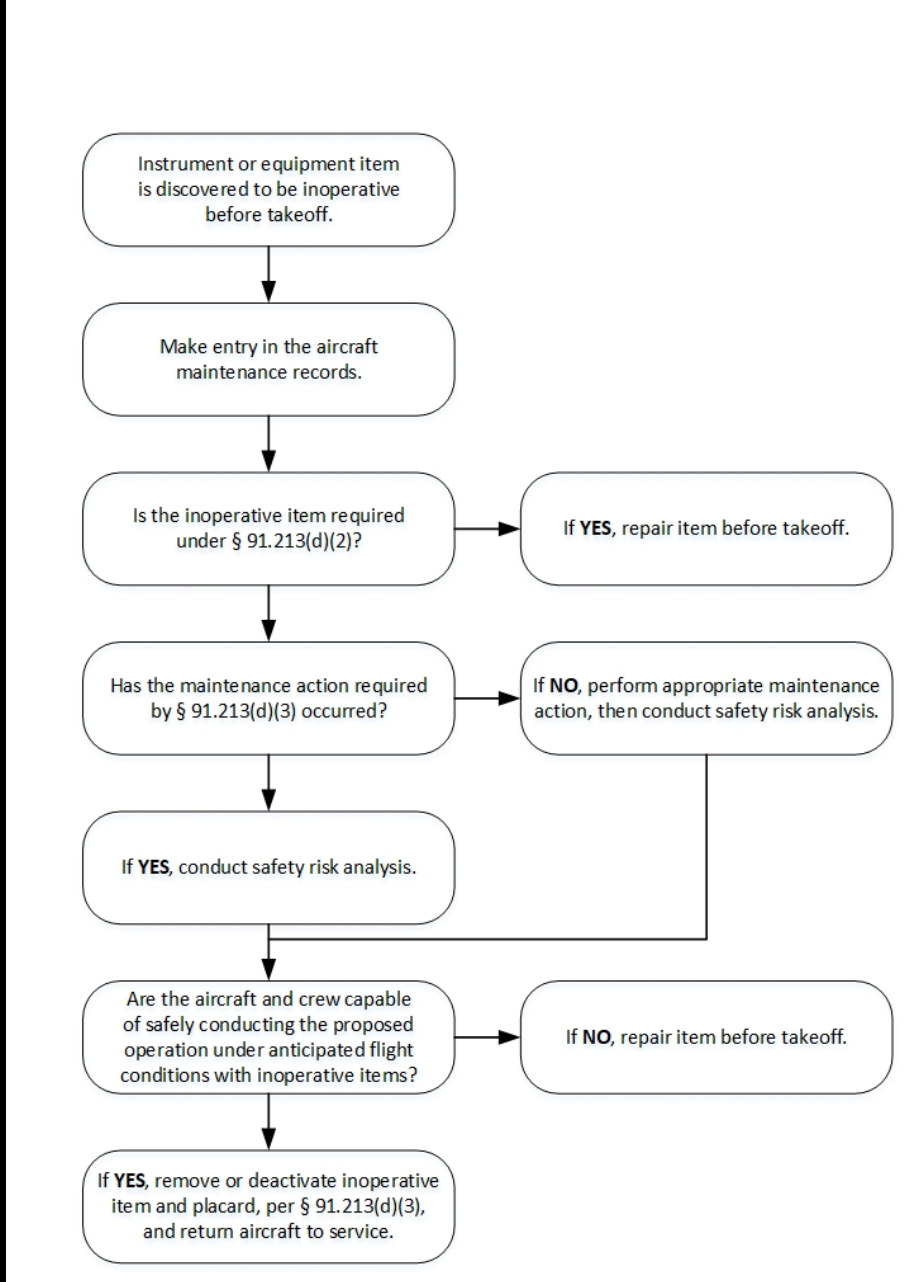
DATE “DRAFT” AC 91-67A
4-4
Figure 4-1. PIC Decision Sequence
Figure 4-1 illustrates the sequence of events involved in operating an aircraft under § 91.213(d)
with inoperative items.

DATE “DRAFT” AC 91-67A
5-1
CHAPTER 5. CONDUCTING OPERATIONS WITH AN MEL
5.1 Operating with an MEL. If the aircraft has an MEL and LOA, the PIC may defer
allowable inoperative items by following the MEL procedures. When operating under the
provisions of § 91.213(a), the MEL and LOA must be available to the PIC. The MEL
may be in hardcopy format (printed) or via another method approved by the
Administrator (e.g., electronically). Indirect methods of MEL and LOA access, such as
telephone, radio, or data link, are not acceptable.
5.1.1 Applicability. MEL item relief may be applied to an MEL item newly identified as
inoperative up until takeoff. Takeoff, for the purposes of this AC, is defined as the act of
beginning a flight in which an aircraft is accelerated from a state of rest to that of flight.
For the purposes of MEL relief, this means the point at which the pilot begins to apply
power to initiate the takeoff from the runway or takeoff surface.
5.1.2 Item Failures During or After Engine Start, During Taxi, or Any Time Prior to Takeoff.
The MEL does not allow a flight to continue if a discrepancy is discovered before
takeoff, but not yet not addressed by repair or deferral. An aircraft must not takeoff with
inoperative items until the MEL deferral process has been completed. For instance, if the
MEL procedures for a specific item require a mechanic’s inspection, takeoff would be
prohibited until the required inspection is complete.
5.1.3 Item Failures After Takeoff. MEL relief does not apply for item failures occurring after
takeoff. After takeoff, the flightcrew should handle item failures in accordance with the
Airplane Flight Manual (AFM)/Rotorcraft Flight Manual (RFM) approved procedures. A
record of the equipment failure must be made in the aircraft’s maintenance records.
Before the next takeoff, the inoperative item must either be repaired, or the PIC must
follow MEL deferral procedures. Therefore, any item failure that occurs after takeoff,
must be addressed before the subsequent takeoff.
5.1.4 Safety Risk Analysis of Proposed Operation with Inoperative Items. Before operating an
aircraft with inoperative items using an MEL, the operator should carefully evaluate
whether the aircraft and crew are capable of safely conducting the proposed operation
under anticipated flight conditions with the inoperative equipment. The safety risk
analysis should include, but is not limited to:
• A determination that the inoperative instrument or equipment, including the failure
condition, does not constitute a hazard to the operation;
• A determination that the inoperative instrument or equipment is not required for the
planned operation, such as oceanic, remote, or international operations;
• Interrelationship and effects of multiple instrument or equipment item failures;
• Adverse weather;
• Night operations;
• Departure and destination airports and their surrounding environment;

DATE “DRAFT” AC 91-67A
5-2
• En route environment;
• Diversion and alternate airport options;
• Additional crew workload caused by inoperative items; and
• Crew fatigue.
5.2 Documentation of Deferred Items. A means of recording discrepancies and corrective
actions must be in the aircraft and available to the PIC when operating under the
provisions of § 91.213(a). Additionally, when an instrument or equipment item is
discovered to be inoperative, an entry must be made in the aircraft maintenance records.
Since some operators do not carry aircraft logbooks in the aircraft, a discrepancy record
or log is an acceptable alternative. When an operator uses this type of discrepancy log in
lieu of the aircraft maintenance records, the operator must retain the log as a part of the
aircraft’s records, per § 91.417(b). If the operator elects to use the aircraft maintenance
record to log inoperative items, that portion of the record must be carried onboard the
aircraft during all operations.
5.3 Placarding. Each inoperative item must be placarded (e.g., marked as “inoperative”) to
inform and remind the flightcrew and maintenance personnel of the item’s condition. To
the extent practical, placards will be securely affixed to a location adjacent to the control
or indicator for the item affected. The placard is not required to be in a particular form,
but will be legible and visible to the flightcrew; may not obscure other controls or
indicators; and should not interfere with aircraft operation. Unless otherwise specified
(e.g., in an MEL proviso), placard wording and location will be determined by the aircraft
operator.
5.4 Performing (M) and (O) Procedures. The presence of either (M) or (O) symbols (as
explained below) in the “Remarks or Exceptions” column of the MEL indicate a specific
(M) or (O) procedure is required to be accomplished. In addition to carrying the
documents that comprise the MEL onboard the aircraft, the operator must have available
any applicable technical manuals needed to accomplish (M) and (O) procedures when
operating under the provisions of § 91.213(a).
5.4.1 (M) Procedures. The (M) symbol indicates a specific maintenance procedure that must be
accomplished prior to operation with the listed item inoperative. Normally, (M)
procedures are accomplished by qualified maintenance personnel; however, other
personnel may be qualified and authorized to perform certain functions. Procedures
requiring specialized knowledge or skill, or requiring the use of tools or test equipment,
should be accomplished by maintenance personnel. The satisfactory accomplishment of
all (M) procedures, regardless of who performs them, is the responsibility of the aircraft
operator. Appropriate procedures are required as a part of the aircraft operator’s MEL.
5.4.2 (O) Procedures. The (O) symbol indicates a specific operations procedure that must be
accomplished prior to operation with the listed item inoperative. Normally, these
procedures are accomplished by the flightcrew; however, other personnel may be
qualified and authorized to perform certain functions. These procedures may be required
for flight planning purposes, or they may require action by the flightcrew. Additionally,

DATE “DRAFT” AC 91-67A
5-3
MEL items affecting the aircraft W&B and cargo loading may require procedures for
additional personnel, such as those involved with aircraft load control. The satisfactory
accomplishment of all (O) procedures, regardless of who performs them, is the
responsibility of the aircraft operator. Appropriate procedures are required as a part of the
aircraft operator’s MEL.
5.5 Repair of Deferred Instruments or Equipment Items. The MEL is intended to permit
operations with inoperative items for the minimum period of time necessary until repairs
can be accomplished. It is important repairs be accomplished at the earliest opportunity in
order to return the aircraft to its design level of safety and reliability.
5.5.1 Accomplishing Repair, Replacement, Removal, or Inspection of Deferred Items. The
repair category intervals indicated by the letters A, B, C, and D in column 1 of the
MMEL are not applicable to an MEL approved under the provisions of § 91.213(a), but
operators must comply with any provisos defining a repair interval (e.g., flights, flight
legs, cycles, hours, days, etc.). The operator must have any inoperative items, which are
permitted to be inoperative, either repaired, replaced, removed, or inspected within the
proviso-defined repair interval period or at the next required aircraft inspection,
whichever comes first. If an operator chooses to defer maintenance on an inoperative
item beyond a required aircraft inspection, certificated maintenance personnel must
inspect the item for conformance with the requirements of the MEL and § 43.11(b).
• The person performing the required inspection must give the aircraft owner or lessee
a signed and dated list of all discrepancies not repaired.
• The person performing the required inspection must ensure each inoperative item that
remains inoperative is placarded appropriately.
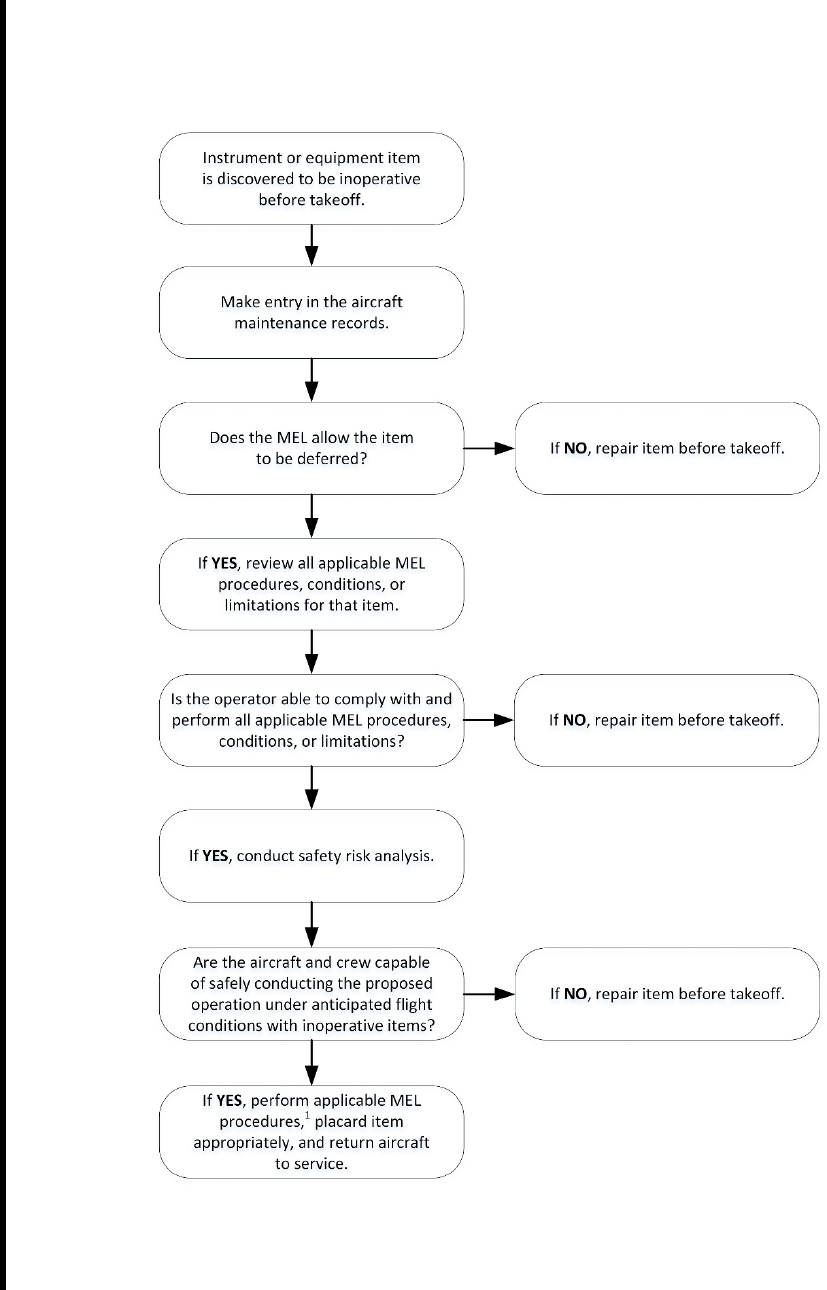
DATE “DRAFT” AC 91-67A
5-4
Figure 5-1. PIC Decision Sequence
Figure 5-1 illustrates the sequence of events involved in using an MEL to operate an aircraft with
inoperative items. This chart is not required to be part of the operator’s MEL.
1
The PIC must ensure all applicable (M) and/or (O) procedures are performed and must
comply with applicable conditions or limitations listed in the “Remarks or Exceptions”
column of the MEL.

DATE “DRAFT” AC 91-67A
6-1
CHAPTER 6. APPLICATION FOR MEL LETTER OF AUTHORIZATION (LOA)
6.1 Application for an MEL Approval Issued Under LOA D095. An operator applying for
an MEL approval issued under LOA D095 must submit a signed, written request for
issuance of LOA D095 to the responsible Flight Standards office having jurisdiction over
the area in which the operator’s principal base of operations is located. An electronic
signature, or a signed and scanned request transmitted via email is acceptable. The
operator’s request must contain the information described in Figure 6-1, Sample
LOA D095 Request Letter. Except for reapplication after cancellation, rescission, or
revocation, the operator is not required to submit the procedures document to the FAA.
See Chapter 7 for detailed information on the procedures document content.
6.2 Application for an MEL Approval Issued Under LOA D195. An operator applying for
an MEL approval issued under LOA D195 must submit a signed, written request for
issuance of LOA D195, along with a copy of the operator-developed MEL (an electronic
copy is preferred), to the responsible Flight Standards office having jurisdiction over the
area in which the operator’s principal base of operations is located. An electronic
signature, or a signed and scanned request transmitted via email is acceptable. The
operator’s request must contain the information described in Figure 6-2, Sample
LOA D195 Request Letter for an Operator-Developed MEL That Conforms to the
Content Described in AC 91-67. Operators who conduct international operations and
currently hold an LOA D095 should state so in their request letter. See Chapter 8 for
detailed information on operator-developed MEL content.
6.3 Request for Approval of an MEL That Does Not Conform to This AC. An operator
may request approval of an operator-developed MEL that does not conform to the content
described in this AC. If an operator-developed MEL does not conform to the content
described in this AC, the operator should:
1. Submit a signed, written request to the responsible Flight Standards office for
approval of an MEL that does not conform to this AC (see Figure 6-3, Sample MEL
Approval Request Letter for an Operator-Developed MEL That Does Not Conform to
the Content Described in AC 91-67);
2. Explain in their request letter how their MEL meets the requirements of § 91.213(a);
3. Provide a copy of the operator-developed MEL (an electronic copy is preferred) with
the request; and
4. Be advised that approval of the MEL may be delayed.
6.4 Oversight. The FAA may request to review a procedures document or
operator-developed MEL during normal surveillance activity. If the FAA determines the
MEL does not comply with the conditions and limitations of the operator’s MEL LOA,
the FAA may rescind the LOA.

DATE “DRAFT” AC 91-67A
6-2
Figure 6-1. Sample LOA D095 Request Letter
To: Responsible Flight Standards Office
I request issuance of a Letter of Authorization (LOA) D095 under the provisions of Title 14 of
the Code of Federal Regulations (14 CFR) part 91, § 91.213 to [complete legal name of operator]
for the aircraft listed below.
I attest that I have a copy of the [state the make, model, series (M/M/S) Master Minimum
Equipment List (MMEL), revision number (e.g., Gulfstream Aerospace GVII-G500/G600
MMEL, revision 3)] and have developed a procedures document for the listed aircraft. The
procedures document conforms to the content described in Advisory Circular (AC) 91-67, and
contains:
1. The name(s) of the operator(s), aircraft serial and registration numbers (or “Fleet”),
aircraft M/M/S, and the MMEL revision number on which the minimum equipment list
(MEL) is based;
2. Maintenance (M) and Operations (O) procedures that correspond with the (M) and (O)
provisos listed in the MMEL;
3. A list of applicable MMEL items that contain the statement “as required by 14 CFR”;
4. Definitions, per current MMEL Policy Letter (PL)-25; and
5. A preamble, per current MMEL PL-36.
Principal base of operations address of the operator:
[Mailing address of the operator, if different from the principal address]:
Responsible Person’s full name, email address, and/or telephone number [part 91 only]:
Aircraft serial number:
Aircraft registration number:
Aircraft M/M/S:
[List information for additional aircraft, if applicable]
Sincerely,
[Signature]
[Full name of the person legally authorized to make the request on behalf of the operator]

DATE “DRAFT” AC 91-67A
6-3
Figure 6-2. Sample LOA D195 Request Letter for an Operator-Developed MEL That
Conforms to the Content Described in AC 91-67
To: Responsible Flight Standards Office
I request issuance of a Letter of Authorization (LOA) D195 under the provisions of Title 14 of
the Code of Federal Regulations (14 CFR) part 91, § 91.213 to [complete legal name of operator]
for the aircraft listed below.
I attest that the attached minimum equipment list (MEL) conforms to the content described in
Advisory Circular (AC) 91-67, is based on the [state the make, model, series (M/M/S) Master
Minimum Equipment List (MMEL), revision number (e.g., Gulfstream Aerospace
GVII-G500/G600 MMEL, revision 3)], is not less restrictive than the MMEL, and contains:
1. The name(s) of the operator(s), aircraft serial and registration numbers (or “Fleet”),
aircraft M/M/S, and the MMEL revision number on which the MEL is based;
2. A table of contents;
3. A log of revisions;
4. Definitions, per current MMEL Policy Letter (PL)-25;
5. A preamble, per current MMEL PL-36;
6. Control page(s);
7. Air Transport Association of America (ATA) [or Joint Aircraft System/Component
(JASC)] coded system sections;
8. Maintenance (M) and Operations (O) procedures that correspond with the (M) and (O)
provisos listed in the MMEL; and
9. Applicable MMEL items that contain the statement “as required by 14 CFR.”
Principal base of operations address of the operator:
[Mailing address of the operator, if different from the principal address]:
Responsible person’s full name, email address, and/or telephone number [part 91 only]:
Aircraft serial number:
Aircraft registration number:
Aircraft M/M/S:
[List information for additional aircraft, if applicable]
Sincerely,
[Signature]
[Full name of the person legally authorized to make the request on behalf of the operator]

DATE “DRAFT” AC 91-67A
6-4
Figure 6-3. Sample LOA D195 Request Letter for an Operator-Developed MEL That Does
Not Conform to the Content Described in AC 91-67
To: Responsible Flight Standards Office
I request review and approval of a Title 14 of the Code of Federal Regulations (14 CFR) part 91
minimum equipment list (MEL) that does not conform to the content described in Advisory
Circular (AC) 91-67. Upon review and approval, I request issuance of Letter of Authorization
(LOA) D195 under the provisions of part 91, § 91.213 to [complete legal name of operator] for
the aircraft listed below.
[Explain how the MEL conforms to the requirements of § 91.213(a)]
I have attached the proposed MEL for your review and approval.
Principal base of operations address of the operator:
[Mailing address of the operator, if different from the principal address]
Responsible Person’s full name, email address, and/or telephone number [part 91 only]:
Aircraft serial number:
Aircraft registration number:
Aircraft make, model, and series (M/M/S):
[List information for additional aircraft, if applicable]
Sincerely,
[Signature]
[Full name of the person legally authorized to make the request on behalf of the operator]

DATE “DRAFT” AC 91-67A
7-1
CHAPTER 7. CONTENT OF A PROCEDURES DOCUMENT
7.1 MEL Approval Under LOA D095. The MEL approved under LOA D095 consists of
three documents: the LOA, the aircraft M/M/S-specific MMEL, and the procedures
document.
Note: Operators may include MMEL PLs with a current GC designation, Design
Change Approval Letters, or any design change approval described in Chapter 11,
as an attachment to the MMEL.
7.2 Procedures Document Content. This chapter provides information to ensure the
procedures document meets the requirements listed in LOA D095.
1. The procedures document must contain the name(s) of the operator(s), aircraft serial
and registration numbers (or “Fleet”), aircraft M/M/S, and the MMEL revision
number on which the MEL is based.
2. The procedures document must include specific content based on the items installed
on the operator’s aircraft. The procedures document may omit an MMEL item if the
item or configuration is not installed or if the operator elects to not take relief. If the
operator does not take relief for an installed item, the procedures document will
clearly state that no MEL relief is provided for that item and it must be operative for
takeoff.
3. A procedures document should incorporate the phraseology used in the MMEL,
wherever appropriate, to ensure clarity and standardization.
7.3 Procedures Document Required Sections. The procedures document must contain the
following sections:
7.3.1 (M) and (O) Procedures. The presence of either (M) or (O) symbols in the MMEL
“Remarks or Exceptions” column indicates specific (M) or (O) procedures are required to
be accomplished prior to operation when the item is inoperative. The procedures
document must contain (M) and (O) procedures corresponding to the (M) and (O)
provisos listed in the MMEL for all installed equipment for which the operator desires
MEL relief. The procedures document’s (M) and (O) procedures:
1. Must meet the intent of the (M) and (O) provisos in the MMEL.
2. Must never be less restrictive than the (M) and (O) provisos in the MMEL.
3. May be either manufacturer’s (M) and (O) procedures or operator-developed (M) and
(O) procedures.
Note: It is recommended, although not required, that operators use the Original
Equipment Manufacturer’s (OEM) document (e.g., maintenance operational
placarding procedures (MOPP), dispatch deviation guide (DDG), or maintenance
policy manual (MPM)) as the required (M) and (O) procedures element.

DATE “DRAFT” AC 91-67A
7-2
4. May be developed from the manufacturer’s (M) and (O) procedures or the guidance
provided in the manufacturer’s AFM, RFM, or Aircraft Maintenance Manual
(AMM), manufacturer’s recommendations, engineering specifications, or other
appropriate sources. Operators are not required to copy the manufacturer’s
recommended (M) and (O) procedures verbatim in their MEL. When a
manufacturer-recommended procedure exists, the operator may use it as published or
develop equivalent procedures for their procedures document.
5. Must comply with all 14 CFR requirements and must not deviate from the AFM/RFM
limitations, emergency procedures, or ADs, all of which take precedence over the
MEL.
6. Must specify suitable conditions and limitations in the form of placards, maintenance
procedures, crew operating procedures, and other restrictions, which must be
accomplished by the operator to ensure an ALoS is maintained.
7. May reference a procedure in an FAA-approved or FAA-accepted manual. The
manual reference must be preceded by a specific instruction defining the action
required and direct the use of that manual to include specific chapter, section, task, or
paragraph references for the procedure.
7.3.2 As Required by 14 CFR. An operator must develop a list of all MMEL items containing
the statement “as required by 14 CFR” or any similar statement, based on the items
installed on the operator’s aircraft for which the operator desires MEL relief. The
procedures document will: (1) list the specific 14 CFR part and section (e.g., 14 CFR
part 91, § 91.209) (and the operator must carry the applicable 14 CFR section on board
the aircraft), or (2) specify the requirements and/or limitations to conduct the flight in
accordance with the appropriate 14 CFR regulations. MMEL PL-25 contains a list of
regulatory references according to the ATA chapter number. This list is not all-inclusive.
Note: The term “14 CFR” has replaced “Federal aviation regulations (FAR)” as
the current reference to Federal regulations pertaining to aviation. Many MMELs
and MELs still contain the acronym “FAR” and should be updated to “14 CFR”
as they are revised.
7.3.3 Definitions. MMEL and MEL definitions are contained in MMEL PL-25. Operators must
include all applicable definitions in their procedures document. Not all of the MMEL
definitions are required to be in a procedures document, as some are related to format
issues, specific aircraft types, and certain types of operations. Certain portions of an
MMEL definition may be edited or are not required, but the intent of the definition must
be the same and must not be less restrictive than the definition in MMEL PL-25.
Operators may download MMEL PLs from the “MMELs and AED Guidance
Documents” section in DRS at https://drs.faa.gov.
7.3.4 Preamble. The preamble contained in MMEL PL-36 is applicable to all § 91.213(a) MEL
approvals under LOA D095. This preamble must be reproduced verbatim in the
procedures document.
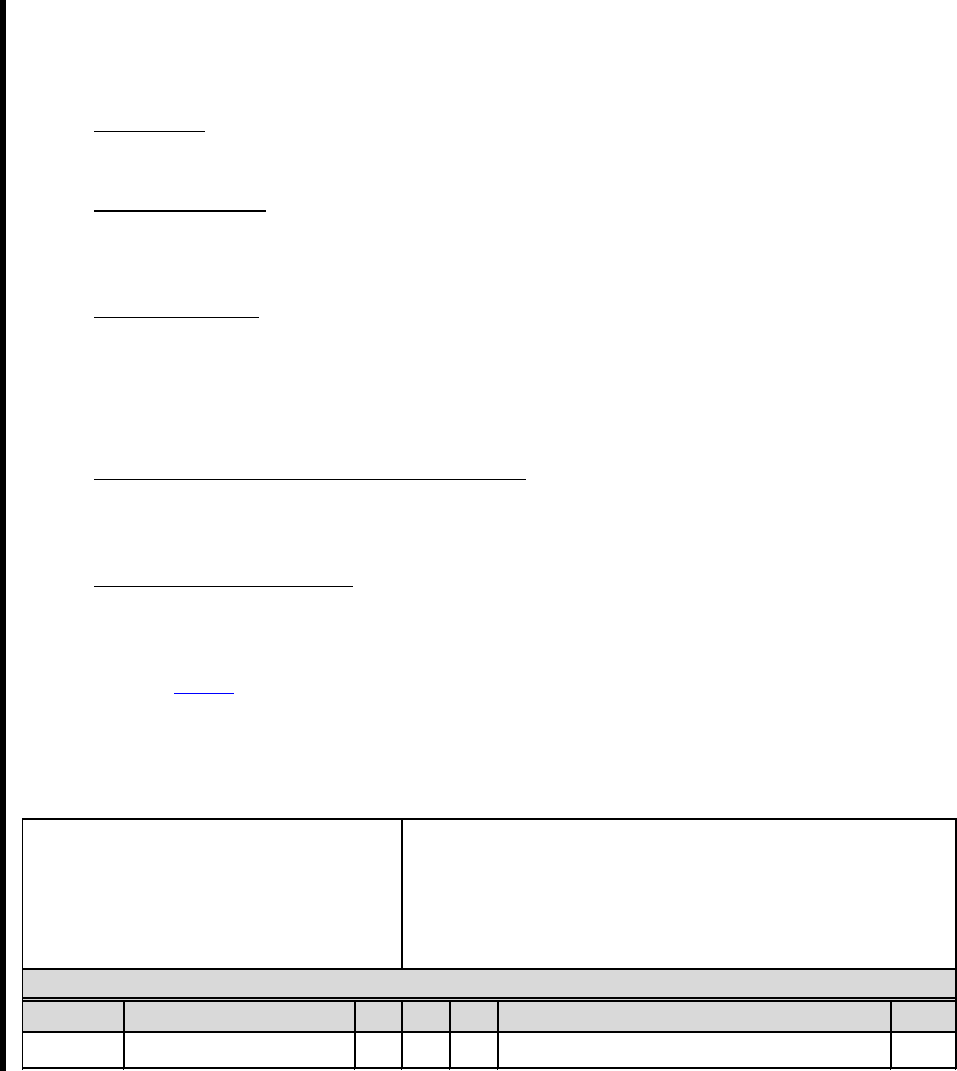
DATE “DRAFT” AC 91-67A
7-3
7.4 Procedures Document Optional Sections. An operator may include the optional
sections listed below. The operator may also include additional sections containing
information relevant to their MEL.
7.4.1 Cover Page. The cover page format and information may be the same as the MMEL. The
cover page content and format may vary due to operator preference.
7.4.2 Table of Contents. The table of contents is a list of all the sections/chapters in the
procedures document by title and the corresponding page identification. The format may
vary due to operator preference.
7.4.3 Log of Revisions. The log of revisions contains the revision identification (typically a
number and/or letter) and the date of the revision. At the operator’s discretion, it may also
contain a list of the revised pages, a block for the initials of the person posting the
change, and additional enhancements for use by the operator. The format may vary due to
operator preference.
7.4.4 Control Page (List of Effective Pages (LEP)). Control pages are used for tracking the
status of the MEL and include a record of the revision status or the date of each page of
the operator’s MEL. The format may vary due to operator preference.
7.4.5 Highlights of Change Page. This page list contains a summary of the changes made by
the operator in each revision.
7.5 Example “As Required by 14 CFR” and (M) and (O) Procedures. Figures 7-1(a)
through 7-3(b) are examples of MMEL and corresponding procedures document “as
required by 14 CFR” and (M) and (O) procedures. These are examples only and are not
intended to be used or depicted as actual MMEL or procedures document procedures.
Figure 7-1(a). Example MMEL “As Required by 14 CFR” Statement
Sequence No. Item
1 2 3 4
Change
Bar
33-07
Landing Light C - 0
34. NAVIGATION
As required by 14 CFR
AIRCRAFT:
(insert aircraft make and model)
TABLE KEY
XXX1. REPAIR CATEGORY
XXX2. NO. INSTALLED
XXX3. NO. REQUIRED FOR DISPATCH
XXX4. REMARKS OR EXCEPTIONS
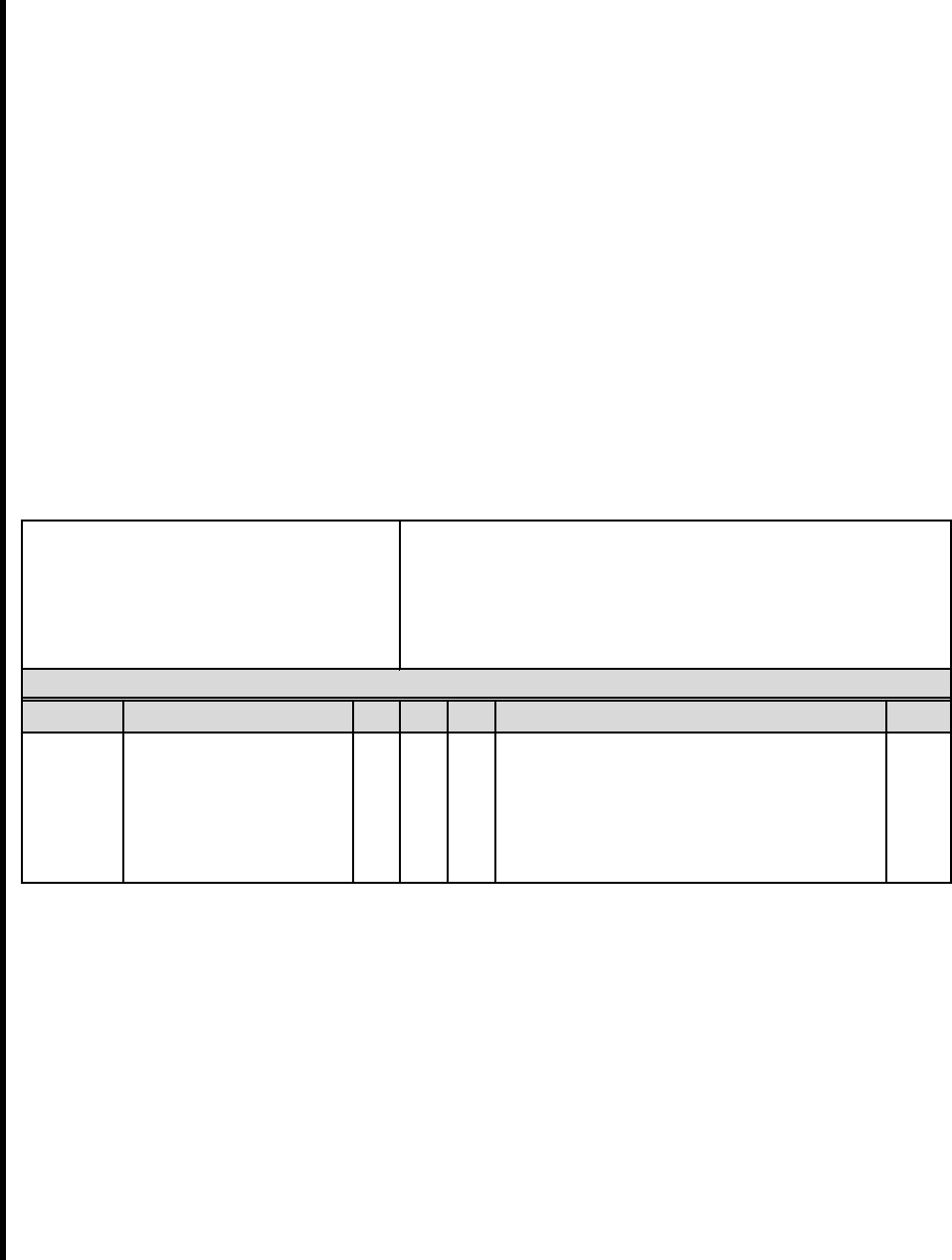
DATE “DRAFT” AC 91-67A
7-4
Figure 7-1(b). Example Procedures Document “As Required by 14 CFR” Regulatory
Reference or Requirement/Limitation
34-33-07: 14 CFR Reference: 14 CFR 91.205(c)(4) and 91.205(d)(1).
[And carry the applicable 14 CFR section on board the aircraft.]
Or
34-33-07: The landing light must be operative for night flight operations if the
aircraft is being operated for hire.
Note: Illustrated in the examples above, the procedures document will: (1) list the
specific 14 CFR part and section (and the operator must carry the applicable
14 CFR section on board the aircraft), or (2) specify the requirements and/or
limitations to conduct the flight in accordance with the appropriate 14 CFR
regulations.
Figure 7-2(a). Example 1 MMEL Maintenance (M) and Operations (O) Symbols and
Provisos
Sequence No. Item
1 2 3 4
Change
Bar
-30-01 Thrust Reverser C 2 0
AIRCRAFT:
(insert aircraft make and model)
TABLE KEY
XXX1. REPAIR CATEGORY
XXX2. NO. INSTALLED
XXX3. NO. REQUIRED FOR DISPATCH
XXX4. REMARKS OR EXCEPTIONS
78. Engine Exhaust
(M)(O) May be inoperative provided:
a) Affected thrust reverser is locked in the
forw
ard thrust position, and
b) Appropriate performance penalties are
applied.
Figure 7-2(b). Example 1 Procedures Document Maintenance (M) and Operations (O)
Procedures
78-30-01:
Maintenance (M) Procedure
Lock affected thrust reverser in the forward thrust position in accordance
with AMM 78-30-12.
Operations (O) Procedure
Refer to AFM Performance Section, Thrust Reverser inoperative for
applicable takeoff and landing penalties.
Note: AMM 78-30-12 and the AFM in the above example are FAA-approved or
FAA-accepted manuals.
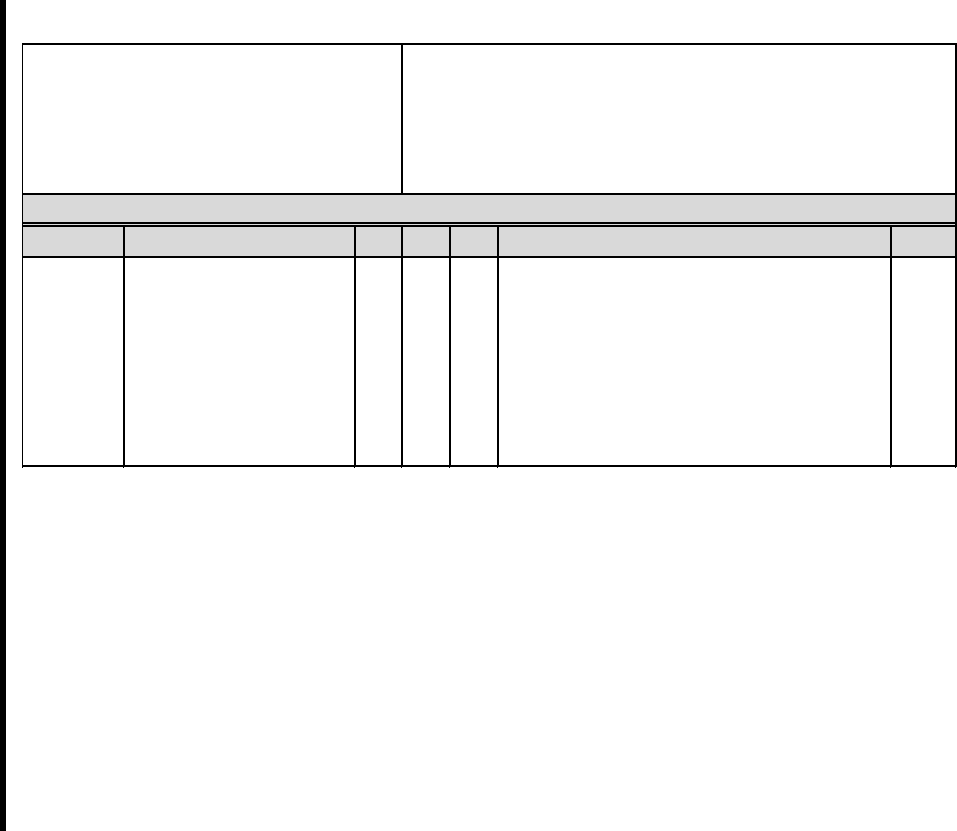
DATE “DRAFT” AC 91-67A
7-5
Figure 7-3(a). Example 2 MMEL Maintenance (M) Symbol and Proviso
Sequence No. Item
1 2 3 4
Change
Bar
28-21-25 XBP Crossfeed Valve A 2 0
28. FUEL
(M) One or more may be inoperative in
closed position provided:
a) Al
l Booster Pumps are operative,
b) Affected XBP Crossfeed Valve is secured
in closed position, and
c) Repairs are made within 3 consecutive
calendar-days.
AIRCRAFT:
(insert aircraft make and model)
TABLE KEY
XXX1. REPAIR CATEGORY
XXX2. NO. INSTALLED
XXX3. NO. REQUIRED FOR DISPATCH
XXX4. REMARKS OR EXCEPTIONS
Figure 7-3(b). Example 2 Procedures Document Maintenance (M) Procedure
28-21-25:
Maintenance (M) Procedure
CROSSFEED VALVE IN CLOSED POSITION:
1. Open the door 170AB.
2. Check that the inoperative XBP crossfeed valve (400QS/410QS) is in
close position (“C”).
NOTE: If not, set the valve to close (“C”) using the lever.
3. Disconnect the electrical connector.
4. Close the door 170AB.
NOTE: Place inoperative placard near MDU.

DATE “DRAFT” AC 91-67A
8-1
CHAPTER 8. CONTENT OF AN OPERATOR-DEVELOPED MEL
8.1 MEL Approval Under LOA D195. The MEL approved under LOA D195 consists of
two documents: the LOA and the operator-developed MEL.
8.2 MEL Content. This chapter provides detailed content requirements to ensure the
operator-developed MEL meets the requirements listed in LOA D195.
1. The MEL must contain the name(s) of the operator(s), aircraft serial and registration
numbers (or “Fleet”), aircraft M/M/S, and the MMEL revision number on which the
MEL is based.
2. Operators may copy the MMEL format outline directly into their MEL. An operator
may also customize their MEL format, provided the format does not make the MEL
in any way less restrictive than the MMEL. An MEL may contain corrections to
MMEL typos, spelling, and punctuation errors.
3. The MEL must include specific content based on the items installed on the operator’s
aircraft. The aircraft operator’s MEL may omit an MMEL item if the item or
configuration is not installed or if the operator elects to not take relief.
4. If an operator elects to take relief for items listed in MMEL PLs with a current CG
designation, Design Change Approval Letters (e.g., STC Relief Approval Letter), or
any design change approval described in Chapter 10, the MEL must comply with the
requirements of paragraph 8.5 below for those items.
5. The MEL should incorporate the phraseology used in the MMEL, wherever
appropriate, to ensure clarity and standardization.
8.3 MEL Required Sections. The operator-developed MEL must contain the following
sections:
8.3.1 Table of Contents. The table of contents is a list of all sections/chapters in the MEL by
title and the corresponding page identification. The format may vary due to operator
preference.
8.3.2 Log of Revisions. The log of revisions contains the MEL revision identification (typically
a number and/or letter) and the date of the MEL revision. At the operator’s discretion, it
may also contain a list of the revised pages, a block for the initials of the person posting
the change, and additional enhancements for use by the operator. The format may vary
due to operator preference.
8.3.3 Definitions. Definitions of the terms used in MMELs and MELs are found in MMEL
PL-25. Operators must include all applicable definitions in their MEL. Not all of the
MMEL PL-25 definitions are required to be in an operator’s MEL, as some are related to
format issues, specific aircraft types, and certain types of operations. Certain portions of a
definition may be edited or are not required, but the intent of the definition must be the
same and must not be less restrictive than the definition in MMEL PL-25. Operators may
download MMEL PLs from the “MMELs and AED Guidance Documents” section in
DRS at https://drs.faa.gov.

DATE “DRAFT” AC 91-67A
8-2
8.3.4 Preamble. The preamble contained in MMEL PL-36 is applicable to all § 91.213(a) MEL
approvals under LOA D195. This preamble must be reproduced verbatim in the MEL.
8.3.5 Control Page (LEP). Control pages are used for tracking the status of the MEL and
include a record of the revision status or the date of each page of the operator’s MEL. It
may also be used as a means of conveying FAA approval of the MEL. The format may
vary due to operator preference. At a minimum, control pages must contain:
• The name(s) of the operator(s);
• A listing of all of the pages in the MEL (individually or the range of applicable pages
for a given section/chapter), including the date of all pages and their number or
revision number; and
• The MMEL revision number on which the MEL is based.
8.3.6 ATA/JASC Coded System Sections. These sections are organized by aircraft system
according to the ATA/JASC coded numbering system and include individual item
sequence numbers, items, repair categories, number of items installed, number of items
required for dispatch, remarks or exceptions, and (M) and (O) procedures. See
paragraph 8.5 below for additional information.
8.4 MEL Optional Sections. The operator-developed MEL may include the optional
sections listed below. The operator may also include additional sections containing
information relevant to their MEL.
8.4.1 Cover Page. The cover page format and information may be the same as the MMEL.
8.4.2 Highlights of Change Page. This page list contains a summary of the changes made by
the operator in each revision.
8.5 ATA/JASC Coded System Sections. The operator-developed MEL must be organized
using the MMEL ATA/JASC coded numbering system. The MEL ATA/JASC coded
system sections will include a list of individual items in the aircraft, together with
requirements for operation when the items are inoperative. Each coded system section
will be further broken down into individual item sequence numbers.
8.5.1 ATA/JASC System Code Numbers. Operators must use the ATA or JASC coded
numbering system. The ATA/JASC numbering system provides an industrywide standard
for numbering aircraft systems and is relevant for all aircraft.
8.5.2 Individual Item Sequence Number and Items. Individual item sequence numbers are the
unique identification for each item within an ATA/JASC system category. The
numbering scheme may be modified to align with the aircraft operator’s specific MEL
format and may differ from the MMEL. They are not required to match ATA/JASC
system item numbers.

DATE “DRAFT” AC 91-67A
8-3
8.5.2.1 A triple asterisk (***) below the system number in column 1 of an MMEL
indicates an item that is not required by regulation has been installed on some
models of a particular aircraft M/M/S. An operator may not carry the “***”
symbol over to the MEL. Operators omit the symbol and use a system
sequence number when the item is installed on one or more of the operator’s
aircraft.
8.5.2.2 An operator is not required to list all MMEL items in their MEL; however, if a
particular item is not in the operator’s MEL, then the item must be fully
operative at takeoff.
8.5.2.3 Operators may add limitations and restrictions to a particular item beyond
what is required by the MMEL. An operator’s MEL limitations, conditions,
and restrictions must never be less restrictive than the MMEL.
8.5.2.4 Operators will typically list an MEL item exactly as it is in the MMEL. If an
MMEL uses a generic term to describe a particular item, an operator may use
different terminology, provided the operator’s terminology is recognizable
and easily identified with the corresponding MMEL item.
8.5.2.5 When an MEL item contains multiple components, those components may be
listed separately following the item in the MEL.
8.5.2.6 Operators must not list duplicate items, or items listed individually elsewhere
in the MMEL.
8.5.2.7 Individual components of an MMEL or MEL item may not be listed as NEF.
8.5.3 Repair Categories. The repair category intervals indicated by the letters A, B, C, and D in
column 1 of the MMEL are not applicable to an operator-developed MEL, but operators
must comply with any provisos defining a repair interval (e.g., flights, flight legs, cycles,
hours, days, etc.). At an operator’s discretion, repair category interval letters (e.g., A, B,
C, or D) may be omitted from the MEL. If an operator chooses to include repair
categories in their MEL, they may comply with the repair category intervals as a best
practice, but they are not mandatory. Inoperative equipment in all cases must be repaired,
replaced, removed, or inspected by qualified maintenance personnel at the next required
inspection. Refer to § 91.405(c).
8.5.4 Number of Items Installed (Number Installed). The “Number Installed” column of an
MEL lists the number (quantity) of the specified item installed on the aircraft.
8.5.4.1 Variable Number Installed. A dash (-) for the number installed indicates a
variable number (quantity) of the installed item. The use of a dash (-) is
common in fleet MELs where aircraft of the same M/M/S have differing
numbers of specific items. A dash (-) is also used for MEL items that provide
relief for fault messages (e.g., Crew Alert System (CAS), engine indicating
and crew alerting system (EICAS), and electronic centralized aircraft
monitoring (ECAM)). Additionally, operators may use a dash (-) if it is

DATE “DRAFT” AC 91-67A
8-4
impractical to show the actual number of the specific items (including but not
limited to light bulbs, light-emitting diodes (LED), cabin storage
compartments, and cargo lining panels) installed on the aircraft.
8.5.4.2 Items Listed on the MMEL but Not Installed on the Aircraft. An
operator’s MEL does not have to list MMEL items not installed on the
operator’s aircraft. For number continuity in an MEL, operators may choose
to:
1. Simply omit the item from the MEL altogether. The option to either
renumber the subsequent individual items or maintain the original MMEL
sequence numbering is at the operator’s discretion.
2. List the item in the MEL and then show the “Number Installed” as
zero (0). In this case, the “Number Required for Dispatch” would also be
zero (0), and the remark “Not Installed” noted under “Remarks or
Exceptions.” Additionally, in this case, the repair category designators
would be omitted.
8.5.5 Number Required for Dispatch. The “Number Required for Dispatch” column of an MEL
reflects the minimum number (quantity) of items required for flight, provided the
conditions specified in the “Remarks or Exceptions” are met. The number of items
required for dispatch in an MEL may differ from what is required in the MMEL under the
following conditions:
1. The item is listed in the MMEL as optional and is not installed on the aircraft. In this
case, a zero (0) may be shown as the number required, the “Number Installed” shown
as zero (0), and the remark “Not Installed” noted under “Remarks or Exceptions.”
Note: An operator’s MEL does not have to list MMEL items not installed on the
operator’s aircraft.
2. The “Number Required for Dispatch” is followed by a dash (-) in the MMEL. Where
the MMEL shows a variable number (-) required for dispatch, the MEL may reflect
the actual number required for dispatch or an alternate means of configuration control
approved by the Administrator. An aircraft operator’s MEL may contain a dash (-)
where the number required is based on the conditions of flight, such as adequate
cockpit lighting. Fleet configuration differences (where applicable) and the dispatch
requirements must be specified in the “Remarks or Exceptions” section.
3. The number required for dispatch in the MEL is not less restrictive than the MMEL.
8.5.6 Remarks or Exceptions. The “Remarks or Exceptions” column includes provisos, notes,
“as required by 14 CFR” requirements and/or limitations, and (M) and (O) symbols.
Some MMEL “Remarks or Exceptions” are intentionally general to accommodate a
variety of operators and operating rules. An MEL must expand upon these general
MMEL “Remarks or Exceptions,” as required to adequately and safely address an
operator’s particular operations and operating rules. See the examples in paragraph 8.6
below.

DATE “DRAFT” AC 91-67A
8-5
8.5.6.1 Provisos. Provisos are conditions or limitations that must be complied with
for operation with the listed item inoperative. The term indicates by
association that an item may be deferred, provided that certain conditions are
met. If more than one proviso applies, they will be listed separately by number
or lowercase letter. For example, a proviso may allow an item to be
inoperative provided the airplane is not operated in Extended Operations
(ETOPS); and another proviso requires the aircraft only be operated under
VFR when that same item is inoperative. In most instances, MEL provisos
will be written verbatim from the MMEL, but there are cases where it is
acceptable to deviate from the MMEL. However, in every case, the operator
MEL will not be less restrictive than the MMEL or the relevant 14 CFR
requirement. For example, deleting “established and” from the phrase
“alternate procedures are established and used” would not be less restrictive
since the inclusion of the procedure in the MEL meets the requirement to
“establish” the procedure.
8.5.6.2 Notes. Notes provide additional information for flightcrew or maintenance
consideration. Notes are used to identify applicable material intended to assist
with compliance but do not relieve the aircraft operator of the responsibility
for compliance with all applicable requirements. Additional notes may be
added to the aircraft operator’s MEL, as appropriate. Some notes in the
MMEL may not be appropriate in an aircraft operator’s MEL and may be
amended or deleted. Notes are not a part of the proviso. Where more than one
note is included, they will be numbered accordingly (e.g., NOTE 1, NOTE 2).
Notes are repeated, as necessary, following each applicable proviso.
8.5.6.2.1 Notes may contain a suggestion to aid with compliance such as: “The
operator’s alternate procedures should include reviewing wind shear
avoidance and wind shear recovery procedures.”
8.5.6.2.2 Notes may be more specific such as: “Flight level (FL) 310 or below must be
maintained if normal operating pack fails,” or, “When FCMC 2 is inoperative,
fuel quantity indication can have dashes on the two last digits.”
8.5.6.2.3 As appropriate, the operator includes the MMEL note in the MEL, or bases
their (M) and (O) procedures on the information contained in the note.
8.5.6.2.4 The information within a note must remain within the scope of the definition
of “notes” in MMEL PL-25.
8.5.6.3 As Required by 14 CFR. The MEL must address all items listed in the
MMEL containing the statement “as required by 14 CFR,” or any similar
statement, based on the items installed on the operator’s aircraft for which the
operator desires MEL relief. The MEL will: (1) list the specific 14 CFR part
and section (e.g., 14 CFR part 91, § 91.209) and the operator must carry the
applicable 14 CFR section on board the aircraft, or (2) specify the
requirements and/or limitations to conduct the flight in accordance with the

DATE “DRAFT” AC 91-67A
8-6
appropriate 14 CFR regulations. The phrase “as required by 14 CFR,” or any
similar statement, is prohibited in an MEL. MMEL PL-25 contains a list of
regulatory references according to ATA chapter number. This list is not
all-inclusive.
Note: The term “14 CFR” has replaced “Federal aviation regulations
(FAR)” as the current reference to Federal regulations pertaining to
aviation. Many MMELs and MELs still contain the acronym “FAR”
and should be updated to “14 CFR” as they are revised.
8.5.6.4 (M) and (O) Symbols and Procedures. The presence of either (M) or (O)
symbols in the MMEL “Remarks or Exceptions” column indicates specific
(M) or (O) procedures are required to be accomplished prior to operation with
the listed item inoperative. The MEL must contain (M) and (O) procedures
corresponding to the (M) and (O) provisos listed in the MMEL for all installed
equipment for which the operator desires MEL relief.
8.5.6.5 MEL (M) and (O) Procedures. The MEL (M) and (O) procedures:
1. Must meet the intent of the (M) and (O) provisos in the MMEL.
2. Must never be less restrictive than the (M) and (O) provisos in the MMEL.
3. May be either manufacturer’s (M) and (O) procedures or
operator-developed (M) and (O) procedures.
4. May be developed from the manufacturer’s (M) and (O) procedures or the
guidance provided in the manufacturer’s AFM, RFM, or AMM,
manufacturer’s recommendations, engineering specifications, and other
appropriate sources. Operators are not required to copy the manufacturer’s
recommended (M) and (O) procedures verbatim in their MEL. When a
manufacturer-recommended procedure exists, the operator may use it as
published or develop equivalent procedures for their procedures
document.
5. Must comply with all 14 CFR requirements and must not deviate from the
AFM/RFM limitations, emergency procedures, or AD, all of which take
precedence over the MEL.
6. Must specify suitable conditions and limitations in the form of placards,
maintenance procedures, crew operating procedures, and other restrictions,
which must be accomplished by the operator. As part of the review and
approval process, the FAA may ask the operator to include additional
instructions within the provisos to ensure that deferral procedures will
continue to provide an ALoS.
7. May be presented in a variety of formats and locations at the discretion of
the operator. For example, they may be placed in separate columns, below
the MEL table or included in an appendix to the MEL. They may be

DATE “DRAFT” AC 91-67A
8-7
included in the “Remarks or Exceptions” column, but must be clearly
distinct from the (M) and (O) provisos.
8. Are subject to FAA review and validation to ensure they are adequate for
the relief sought.
9. May be fully depicted in the operator’s MEL or in another manual. If a
procedure is contained in another manual, the MEL should provide a
specific reference to that manual. See paragraph 8.5.6.6 below.
8.5.6.6 Reference to an FAA-Approved or FAA-Accepted Manual. An operator
may include a reference to the appropriate FAA-approved or FAA-accepted
manual that contains the procedure(s) required to address a particular MEL
item. Only FAA-approved or FAA-accepted manuals may be referenced in the
MEL. The following requirements apply when referencing these manuals:
1. Manual references must be preceded by either a proviso(s) or specific
instruction(s) defining the action required. A single proviso or specific
instruction may have more than one manual reference associated with it.
2. Manual references must direct the use of that manual, including specific
chapter, section, task, or paragraph references. The actual revision
level/date of the manual is not required in the MEL.
3. The proviso or specific instruction and manual reference in the MEL is
considered the means of compliance for MEL purposes and is
FAA-approved. The actual procedure referenced is either FAA-approved
or FAA-accepted depending on the status of the manual referenced.
8.6 Example Proviso, “As Required by 14 CFR,” and (M) and (O) Procedures.
Figures 8-1(a) through 8-4(c) demonstrate the differences between general information
contained in the MMEL “Remarks or Exceptions” column and specific
operator-developed MEL information. These are examples only and are not intended to
be used or depicted as actual MMEL or MEL procedures.
8.6.1 Example Provisos. When an MMEL contains general remarks, such as, “May be
inoperative provided procedures do not require its use,” or “May be inoperative or
missing if alternate procedures are established and used,” the operator must be specific in
the MEL.
8.6.1.1 If there are no operator procedures that rely on the item listed in the MMEL,
then the MEL may simply state, “Procedures do not require its use; may be
inoperative,” or use a similar statement.
8.6.1.2 If there are operator procedures that rely on the item listed in the MMEL, then
the MEL remark states the conditions or limitations which apply to operations
with that equipment inoperative. For example, “May be inoperative provided
overwater operations are not conducted,” or, “May be inoperative provided
long-range communications procedures do not require its use.”
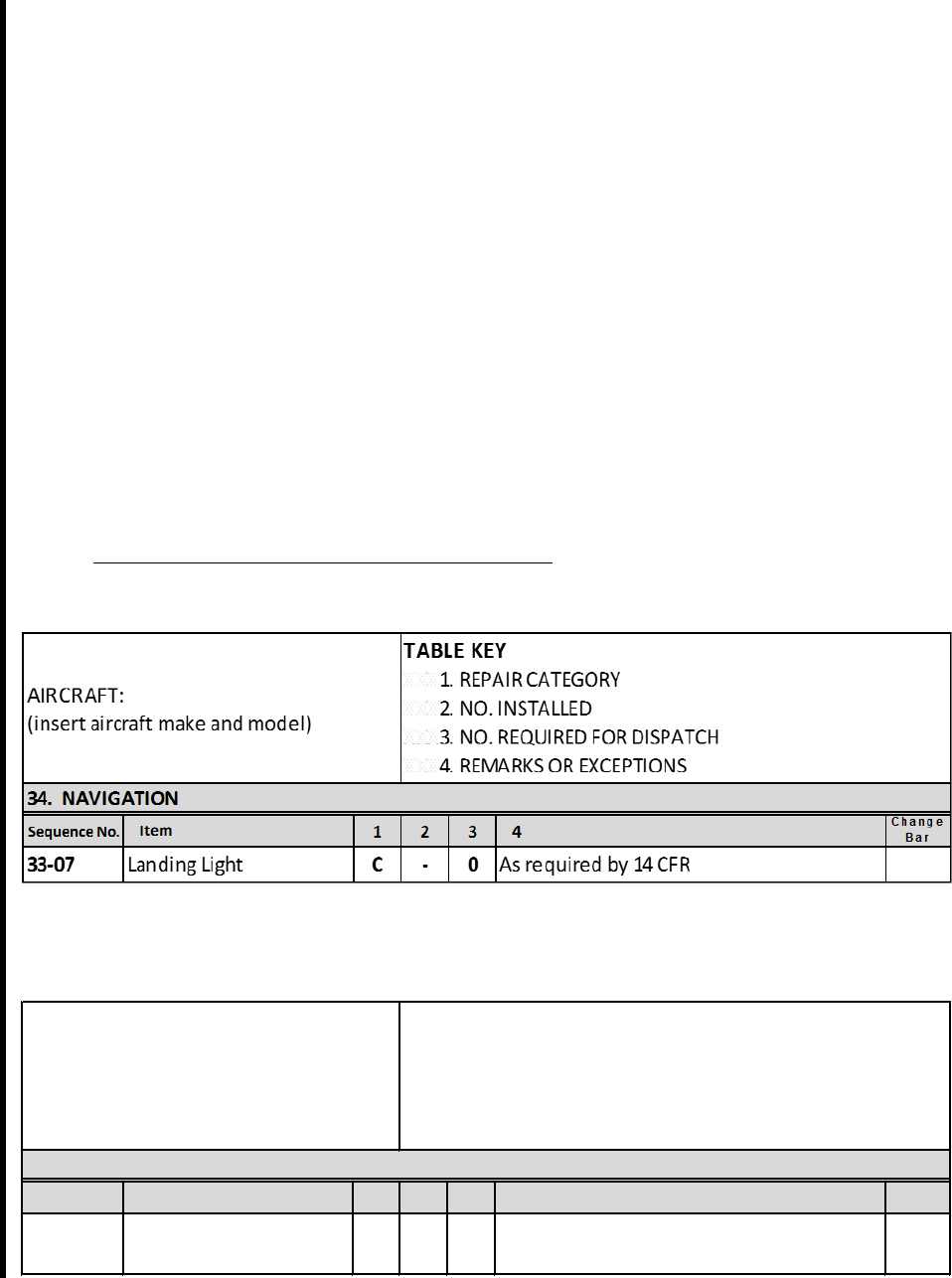
DATE “DRAFT” AC 91-67A
8-8
8.6.1.3 If there are operator procedures that rely on the item listed in the MMEL, but
there is alternate equipment that could be used, then the MEL remark notes
the use of that equipment (and thus, must be operative). For example, “HDG
HOLD Mode. May be inoperative provided HDG SEL or LNAV
autopilot/flight director mode(s) is operative.”
8.6.1.4 There may be cases where the dispatch decision needs to be made by the PIC
based on conditions at the departure or destination airport, or along the route
of flight. These conditions could result from Notice to Air Missions
(NOTAM) information or ground-based equipment outages. These situations
would be known only to the pilot when preparing for specific flights;
therefore, a more general proviso would be appropriate. For example, “May
be inoperative provided departure, en route, or arrival/approach procedures do
not require its use.”
8.6.1.5 Where the MMEL contains an unconditional statement, such as, “May be
inoperative or missing,” the MEL may leave the statement unmodified, or
even omit the statement if the operator’s procedures or operations do not
require the item’s use.
8.6.2 Example “As Required by 14 CFR” Statements.
Figure 8-1(a). Example MMEL General “As Required by 14 CFR” Statement
Figure 8-1(b). Example MEL Specific “As Required by 14 CFR” Regulatory Reference
(The operator must carry the applicable 14 CFR section on board the aircraft.)
Sequence No. Item
1 2 3 4
Change
Bar
33-07
Landing Light 1 0
34. NAVIGATION
14 CFR Reference: 14 CFR 91.205(c)(4) and
91.205(d)(1).
AIRCRAFT:
(insert aircraft make and model)
TABLE KEY
XXX1. REPAIR CATEGORY
XXX2. NO. INSTALLED
XXX3. NO. REQUIRED FOR DISPATCH
XXX4. REMARKS OR EXCEPTIONS
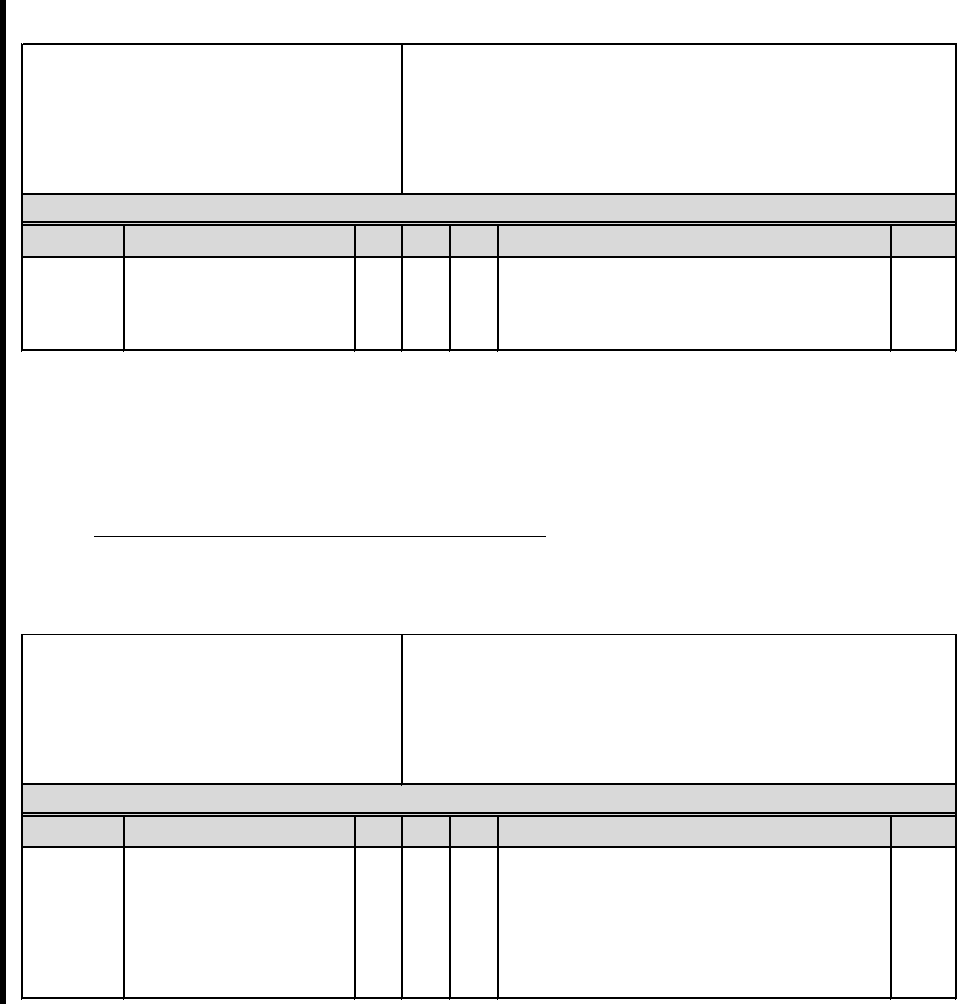
DATE “DRAFT” AC 91-67A
8-9
Figure 8-1(c). Example MEL Specific “As Required by 14 CFR” Requirement/Limitation
Sequence No. Item
1 2 3 4
Change
Bar
33-07
Landing Light 1 0
34. NAVIGATION
The landing light must be operative for
night flight operations if the aircraft is
being o
perated for hire.
AIRCRAFT:
(insert aircraft make and model)
TABLE KEY
XXX1. REPAIR CATEGORY
XXX2. NO. INSTALLED
XXX3. NO. REQUIRED FOR DISPATCH
XXX4. REMARKS OR EXCEPTIONS
Note: Illustrated in the examples above, the MEL will: (1) list the specific
14 CFR part and section (and the operator must carry the applicable 14 CFR
section on board the aircraft), or (2) specify the requirements and/or limitations to
conduct the flight in accordance with the appropriate 14 CFR regulations.
8.6.3 Example (M) and (O) Symbols and Procedures.
Figure 8-2(a). Example 1 MMEL General Maintenance (M) and Operations (O) Symbols
and Provisos
Sequence No. Item
1 2 3 4
Change
Bar
-30-01 Thrust Reverser C 2 0
AIRCRAFT:
(insert aircraft make and model)
TABLE KEY
XXX1. REPAIR CATEGORY
XXX2. NO. INSTALLED
XXX3. NO. REQUIRED FOR DISPATCH
XXX4. REMARKS OR EXCEPTIONS
78. Engine Exhaust
(M)(O) May be inoperative provided:
a) Affected thrust reverser is locked in the
forw
ard thrust position, and
b) Appropriate performance penalties are
applied.
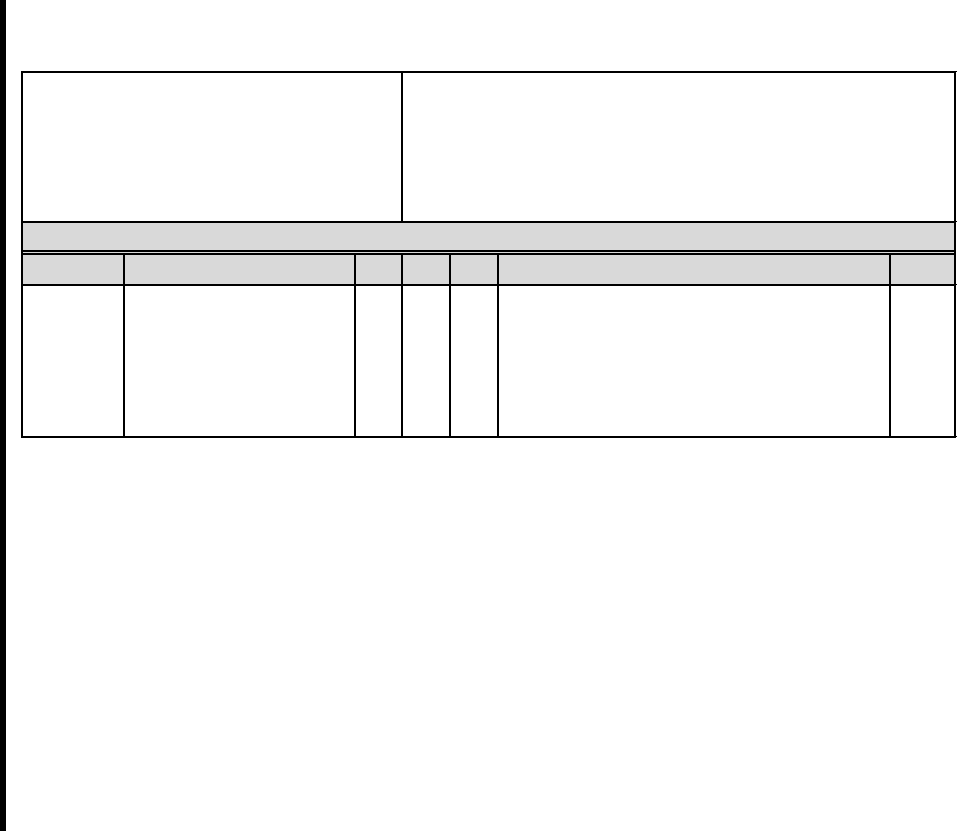
DATE “DRAFT” AC 91-67A
8-10
Figure 8-2(b). Example 1 MEL Specific Maintenance (M) and Operations (O) Symbols
and Provisos
Sequence No. Item
1 2 3 4
Change
Bar
-30-01 Thrust Reverser 2 0
AIRCRAFT:
(insert aircraft make and model)
TABLE KEY
XXX1. REPAIR CATEGORY
XXX2. NO. INSTALLED
XXX3. NO. REQUIRED FOR DISPATCH
XXX4. REMARKS OR EXCEPTIONS
(M)(O) May be inoperative provided:
a) Affected thrust reverser is locked in the
forward thrust position, and
b) Appropriate performance penalties are
applied.
78. Engine Exhaust
Figure 8-2(c). Example 1 Procedures Document Maintenance (M) and Operations (O)
Procedures
78-30-01:
Maintenance (M) Procedure
Lock affected thrust reverser in the forward thrust position in accordance
with AMM 78-30-12.
Operations (O) Procedure
Refer to AFM Performance Section, Thrust Reverser inoperative for
applicable takeoff and landing penalties.
Note: AMM 78-30-12 and the AFM in the above example are FAA-approved or
FAA-accepted manuals.
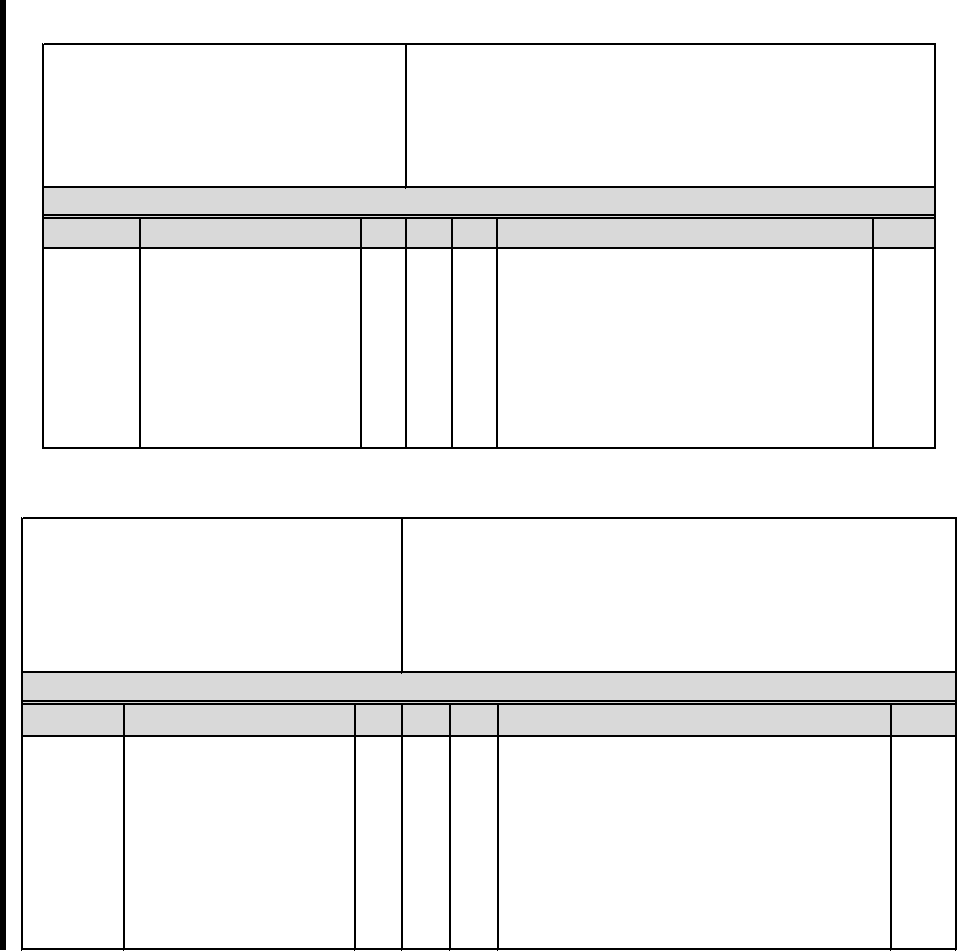
DATE “DRAFT” AC 91-67A
8-11
Figure 8-3(a). Example 2 MMEL General Maintenance (M) Symbol and Proviso
Sequence No. Item
1 2 3 4
Change
Bar
28-21-25 XBP Crossfeed Valve A 2 0
28. FUEL
(M) One or more may be inoperative in
closed position provided:
a) Al
l Booster Pumps are operative,
b) Affected XBP Crossfeed Valve is secured
in closed position, and
c) Repairs are made within 3 consecutive
calendar-days.
AIRCRAFT:
(insert aircraft make and model)
TABLE KEY
XXX1. REPAIR CATEGORY
XXX2. NO. INSTALLED
XXX3. NO. REQUIRED FOR DISPATCH
XXX4. REMARKS OR EXCEPTIONS
Figure 8-3(b). Example 2 MEL Specific Maintenance (M) Symbol and Proviso
Sequence No. Item
1 2 3 4
Change
Bar
28-21-25 XBP Crossfeed Valve 2 0
28. FUEL
(M) One or more may be inoperative in
closed position provided:
a) All Booster Pumps are operative,
b) Affected XBP Crossfeed Valve is secured
in closed position, and
c) Repairs are made within 3 consecutive
calendar-days.
AIRCRAFT:
(insert aircraft make and model)
TABLE KEY
XXX1. REPAIR CATEGORY
XXX2. NO. INSTALLED
XXX3. NO. REQUIRED FOR DISPATCH
XXX4. REMARKS OR EXCEPTIONS
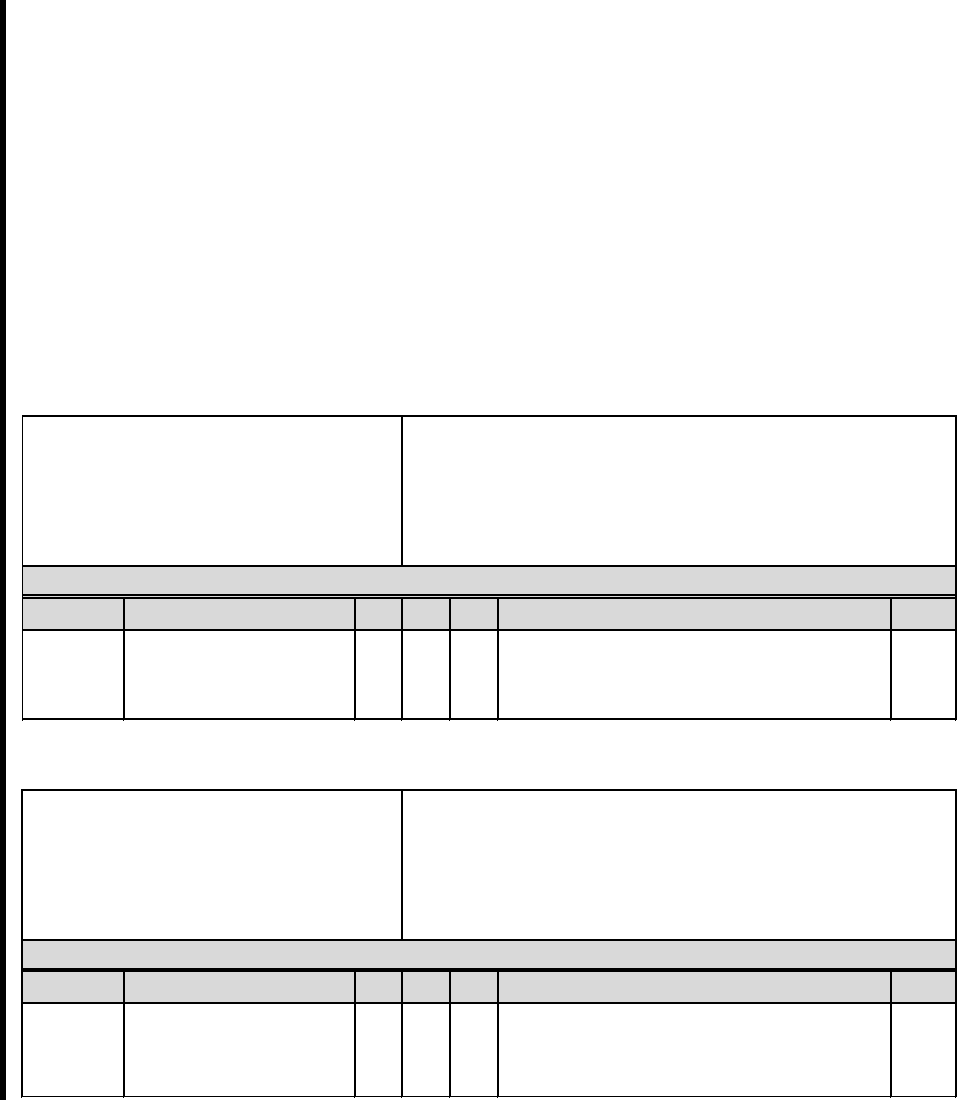
DATE “DRAFT” AC 91-67A
8-12
Figure 8-3(c). Example 2 Procedures Document Maintenance (M) Procedure
28-21-25:
Maintenance (M) Procedure
CROSSFEED VALVE IN CLOSED POSITION:
1. Open the door 170AB.
2. Check that the inoperative XBP crossfeed valve (400QS/410QS) is in
close position (“C”).
NOTE: If not, set the valve to close (“C”) using the lever.
3. Disconnect the electrical connector.
4. Close the door 170AB.
NOTE: Place inoperative placard near MDU.
Figure 8-4(a). Example 3 MMEL General Operation (O) Symbol and Proviso
Sequence No. Item
1 2 3 4
Change
Bar
-43-01 B 1 0
23. COMMUNICATIONS
(O) May be inoperative provided
alternative procedures are established and
used.
Flight Deck to Ground
Interphone System
AIRCRAFT:
(insert aircraft make and model)
TABLE KEY
XXX1. REPAIR CATEGORY
XXX2. NO. INSTALLED
XXX3. NO. REQUIRED FOR DISPATCH
XXX4. REMARKS OR EXCEPTIONS
Figure 8-4(b). Example 3 MEL Specific Operations (O) Symbol and Proviso
Sequence No. Item
1 2 3 4
Change
Bar
-43-01 1 0
23. COMMUNICATIONS
Flight Deck to Ground
Interphone System
(O) May be inoperative provided
alternative ground communications
procedures are used.
AIRCRAFT:
(insert aircraft make and model)
TABLE KEY
XXX1. REPAIR CATEGORY
XXX2. NO. INSTALLED
XXX3. NO. REQUIRED FOR DISPATCH
XXX4. REMARKS OR EXCEPTIONS

DATE “DRAFT” AC 91-67A
8-13
Figure 8-4(c). Example 3 Procedures Document Operations (O) Procedure
23-43-01:
Operations (O) Procedure
(O) May be inoperative provided:
1. Verify to ground crew personnel before main cabin door is closed that
ECAM message NW STRG DISC is displayed.
2. Use company hand signals as required. Refer to Ramp Operations
Manual, Chapter 1, for a complete list of company hand signals.
Note 1: The Ramp Operations Manual in the above example is an
FAA-approved or FAA-accepted manual.
Note 2: The proviso in the above MEL example was changed from the MMEL
proviso because alternative procedures “are established.”

DATE “DRAFT” AC 91-67A
9-1
CHAPTER 9. MEL REVISIONS
9.1 General. MEL revisions may be initiated by either the FAA or the operator. The revision
to an operator’s MEL must comply with the conditions and limitations of the operator’s
MEL LOA.
• MEL revisions for an MMEL used as an MEL under LOA D095 consist of using the
latest mandatory MMEL revision and revising the procedures document, as required.
• MEL revisions for an operator-developed MEL under LOA D195 consist of revising
the operator-developed MEL.
9.1.1 Operator Responsibility to Obtain MMEL Revisions. It is the responsibility of an
operator to obtain the latest revisions to their MMEL, applicable Design Change
Approval Letter, and applicable MMEL PLs. Operators may download these documents
from the “MMELs and AED Guidance Documents” section in DRS at https://drs.faa.gov.
Note: Operators may keep informed of MMEL revisions by subscribing to
receive automatic email notifications for their aircraft. To subscribe, visit
https://service.govdelivery.com/accounts/USFAAMMEL/subscriber/new.
9.1.2 Submission of Revised Operator-Developed MEL to the FAA for Approval. Operators
must submit revisions to an operator-developed MEL under LOA D195 to the responsible
Flight Standards office for approval. An electronic copy is preferred. The revised MEL
may not be used prior to FAA approval. Holders of LOA D095 are not required to submit
a revised procedures document to the FAA.
Note: MEL revisions solely for the purpose of documenting the inapplicability of
a mandatory MMEL revision, or to incorporate revised MMEL PL-25 or PL-36
content, are not required to be submitted to the FAA.
9.2 FAA-Initiated MEL Revisions. An FAA-initiated MEL revision may be due to an
MMEL revision, MMEL PL revision, AD, or deficiencies discovered in the MEL.
9.2.1 MMEL Revision. There are two types of MMEL revisions: nonmandatory/interim, and
mandatory/standard.
9.2.1.1 Nonmandatory/Interim MMEL Revision. A nonmandatory/interim MMEL
revision means that revision to an operator’s MEL is optional and not
required. If the relief granted by the nonmandatory/interim MMEL revision is
applicable to an operator’s aircraft operations, then it is advisable the operator
revise their MEL to incorporate the MMEL revision. If the
nonmandatory/interim MMEL revision is not applicable to an operator’s
aircraft operations, they may disregard the MMEL revision altogether. For
example, a nonmandatory/interim MMEL revision is issued to provide for
optional equipment such as logo lights, which are not installed on all aircraft
of a particular type. Operators operating an aircraft without logo lights may
simply ignore the MMEL revision. Operators operating an aircraft with logo

DATE “DRAFT” AC 91-67A
9-2
lights may choose to incorporate the MMEL revision if the operator would
like MEL relief for inoperative logo lights.
1. A nonmandatory/interim MMEL revision is identified by the current
standard revision number plus a lowercase letter. For example, a
nonmandatory/interim revision following revision 5 will be identified as
revision 5a. There may be subsequent interim revisions to the same
standard revision. These subsequent revisions carry the next lowercase
letter (e.g., 5b, 5c, or 5d).
2. The operator’s MEL revision number does not have to match the MMEL
revision number. Operators may use their own revision numbering system.
3. If an MMEL revision results in a change to the system number or
sequence item number, the operator does not need to modify or close an
open MEL item and reinitiate it under its new number. Instead, the item
may continue to be tracked under its original item number until the item is
repaired and the deferral cleared.
9.2.1.2 Mandatory/Standard MMEL Revision. A mandatory/standard MMEL
revision means that revision to an operator’s MEL is required. A
mandatory/standard MMEL revision includes changes applicable to all
operators using an MEL for a specific aircraft type.
9.2.1.2.1 A mandatory/standard MMEL revision is identified by the next successive
change to the basic MMEL revision number. For example, the next
mandatory/standard revision following nonmandatory/interim revision 6a, 6b,
or 6c is revision 7. The next mandatory/standard revision following revision 7
is revision 8.
9.2.1.2.2 The operator is required to review the mandatory/standard MMEL revision to
determine if the more restrictive revised content is applicable to their aircraft
and operation. If so, the operator must revise their MEL as follows:
1. For an MMEL used as an MEL under LOA D095: Within
90 calendar-days of the date of the MMEL revision, the operator must
revise their procedures document. The revision must address (M) and (O)
or “as required by 14 CFR” procedures, as applicable. If no changes are
determined to be applicable to the aircraft or operator, then the operator is
not required to update the procedures document. However, the FAA
recommends the operator make a statement in the procedures document
that the mandatory revision has been reviewed and determined not to
apply. Regardless, the procedures document must contain the MMEL
revision number on which the MEL is based.
2. For an operator-developed MEL under LOA D195:
a. If the revised content of the mandatory/standard MMEL revision is
applicable, the operator must revise their MEL and incorporate

DATE “DRAFT” AC 91-67A
9-3
applicable changes and submit it to the responsible Flight Standards
office for approval within 90 calendar-days of the date of the MMEL
revision. The revised MEL may not be used prior to FAA approval.
b. If the revised content of the mandatory/standard MMEL revision is not
applicable, within 90 calendar-days of the revision, the operator must
document its inapplicability. Revise the MEL control page(s) or LEP
to indicate the MEL is in compliance with the required MMEL
revision. The operator will retain the previous FAA-signed MEL
control page(s) or LEP within the MEL.
c. Irrespective of applicability, the operator-developed MEL must
contain the MMEL revision number on which the MEL is based.
9.2.1.2.3 If an MMEL revision results in a more restrictive proviso, the operator does
not have to close and reinitiate an existing open MEL item affected by the
revision. Existing MEL items may remain open in accordance with the
original proviso under which the item was initially deferred until such time as
the item is repaired or replaced and the MEL item is closed.
9.2.1.2.4 If an MMEL revision results in a change to the system number or sequence
item number, the operator does not need to modify or close an open MEL item
and reinitiate it under its new number. Instead, the item may continue to be
tracked under its original item number until the item is repaired and the
deferral cleared.
9.2.2 Revisions as a Result of an MMEL PL with a GC Designation. An operator may revise
their MEL based on relief available in an MMEL PL with a current GC designation. An
operator is not required to include GC designation relief in their MEL. See paragraph 2.6
above for detailed information on MMEL PLs with a GC designation.
9.2.3 Revisions Initiated by the Responsible Flight Standards Office. The responsible Flight
Standards office may initiate an MEL revision for reasons such as the issuance of an AD,
upon discovery of deficiencies in the operator’s MEL (including (M) and (O)
procedures), or upon discovery that the operator has modified their aircraft.
9.2.3.1 The responsible Flight Standards office will inform the operator of the need to
revise their MEL in writing and provide the reasons why the revision must be
accomplished.
9.2.3.2 The responsible Flight Standards office will allow the operator
90 calendar-days to complete the revision process. An operator may request
an extension for developing an MEL revision. If the responsible Flight
Standards office determines the safety of flight could be affected (e.g., AD),
they may specify a shorter period of time.
9.2.4 MMEL PL-25 (Definitions) or MMEL PL-36 (Preamble) Revision. A revision to MMEL
PL-25 does not require revision of the operator’s MEL. However, the current revision to
MMEL PL-25 should be incorporated in the next FAA or operator-initiated MEL

DATE “DRAFT” AC 91-67A
9-4
revision. A revision to MMEL PL-36 will require a revision to a procedures document
under LOA D095 or an operator-developed MEL under LOA D195. MEL revisions
solely for the purpose of incorporating revised MMEL PL-25 or PL-36 content, are not
required to be submitted to the FAA.
9.3 Operator-Initiated MEL Revisions. An operator may revise their MEL for a number of
reasons. An operator-initiated MEL revision will not be, in any way, less restrictive than
the MMEL.
9.3.1 Major Aircraft Modifications. An operator may elect to initiate an MEL revision due to
major aircraft modifications, such as an STC, a major alteration (refer to FAA Form 337),
or a modification to the TC.
9.3.2 Installation of Additional Items. An operator may initiate a change based on the
installation of additional items. An operator may add an item to their MEL only if it is
listed in:
1. The MMEL,
2. An applicable Design Change Approval Letter (e.g., STC Relief Approval Letter), or
3. An applicable MMEL PL with a current CG designation.
Note: See Chapter 10 for information on how to obtain relief for an item not
listed in items 1–3 above.
9.3.3 Changes in Operational Complexity. An operator may need to revise their MEL due to
changes in their operational complexity, such as adding a type of operation
(e.g., Reduced Vertical Separation Minimum (RVSM), CAT II/III landing minimums,
etc.). An operator may need to revise their MEL for the purpose of adding or revising (M)
and (O) procedures based on operational complexity.
9.4 Vertical Bar (Change Bar). A vertical bar denotes a change in content. For MMELs, a
vertical bar is placed in the right margin; location in the operator’s MEL is a matter of
choice. A change due to copy editing (e.g., punctuation, spelling, or grammatical
structure) does not need a vertical bar in an MMEL or MEL. All vertical bars applicable
to the previous revision of the MMEL are removed at the next revision. It is permissible
to issue an MMEL or MEL revision without vertical bars when the revision affects most
or all relief items. In which case, in lieu of vertical bars, a note is added to the
“Highlights of Change” page instructing operators to consider all content revised and
indicating that vertical bars are not used. Other alternate means of compliance may be
used if approved by the Administrator.

DATE “DRAFT” AC 91-67A
10-1
CHAPTER 10. MEL RELIEF FOR ITEMS INSTALLED AFTER TYPE
CERTIFICATION
10.1 General. The aircraft design approval holder (DAH) determines the configuration of the
aircraft, the items installed, and the official parts listed during the initial aircraft type
certification process conducted at the time of manufacture. Any subsequent installation or
removal of items may be accomplished only through a STC, an Engineering Order (EO),
a field approval, or other FAA-approved methods (as appropriate).
10.2 Operator NEF Items or Administrative Control Items (ACI). Items listed on an
operator’s NEF program and ACIs are excluded from the requirements for evaluation, as
listed in this chapter.
10.3 MMEL Items and MEL Items. For an item to be listed in an operator’s MEL, it should
first be listed in the MMEL, as the MMEL is the basis for an operator’s MEL. (The only
exception to this policy would be MEL relief added through an MMEL PL with a GC
designation or an AED approval letter, as these are considered addendums to the
MMEL.)
10.3.1 Example of This Concept. If an operator is wanting to add an item to its MEL, such as a
flight management system (FMS) or an autopilot, that item should first appear in the
applicable aircraft’s MMEL as “FMS” or “Autopilot.”
10.3.2 Items Not Listed in an MMEL. An operator may petition the AED to add items to the
applicable aircraft’s MMEL through the FOEB process. This may be accomplished
through the operator’s responsible Flight Standards office or directly to the responsible
AED office. An operator should be prepared to provide the information needed by the
FOEB for this evaluation. See the list of needed items found in paragraph 10.7 below.
10.4 MMEL PL-109. MMEL PL-109, Supplemental Type Certificate (STC) MMEL/MEL
Relief, contains policy specific to MEL relief for items installed by STC and other design
changes.
10.5 STCs. A design change to a TC is often done with an STC. Ideally, MMEL/MEL relief
can be evaluated during the certification of the STC when this is requested by the STC
applicant.
10.5.1 Evaluation of MEL Relief During STC Certification. To obtain MMEL/MEL relief, the
STC applicant involved in the certification of an STC should submit a request for relief in
accordance with the FOEB MMEL Agenda Coordination Process (refer to FAA
Order 8900.1, Volume 8, Chapter 2, Section 3, Flight Operations Evaluation Board, and
AC 21-40, Guide for Obtaining a Supplemental Type Certificate). This submission
should be made early in the certification process to allow MMEL/MEL evaluation
concurrent with the certification process. Requests for relief subsequent to the completion
of the certification process can delay the availability of MMEL/MEL relief for an item.
10.5.2 MEL Relief After STC Certification. STCs issued without concurrent AED evaluation
may be granted relief by request from the operator to the FAA. STCs already listed by

DATE “DRAFT” AC 91-67A
10-2
STC number in the applicable aircraft MMEL, or in an AED approval letter, may be
added to the operator’s MEL through the normal revision process without further
evaluation. However, a PI may coordinate with the AED during this process, as needed.
10.6 Adding Relief for Items Installed After Type Certification. Using the normal revision
process found in Chapter 9, an operator may add relief for items to its MEL through any
of the following solutions listed below.
10.6.1 MMEL Specifically Lists the Relief. Where the MMEL lists the specific STC number
(e.g., ST00733SE) or identifies the specific design change nomenclature (other than
STCs), an operator may add the relief to its MEL.
10.6.2 Design Change Approval Letters. Upon evaluation and approval of a design change, the
AED will submit an approval letter directly to the FAA’s DRS. Operators may download
Design Change Approval Letters from the “MMELs and AED Guidance Documents”
section in DRS at https://drs.faa.gov. The approval letter will contain the allowed relief,
including conditions and provisos, along with remarks or exceptions. Approval letters
will be dated and have revision numbers. Operators may amend their MEL(s) with the
relief for the STC(s) in accordance with the AED approval letter. Paper copies of the
AED approval letter are also acceptable in lieu of the DRS database.
10.6.3 MEL Relief Through MMEL PL With GC Designation. Operators may add relief into
their MEL(s) for an STC through an MMEL PL with a current GC designation. However,
upon AED evaluation of the item (if an evaluation is conducted), operators may have to
amend or remove previously approved relief in their MEL(s). See Chapter 2 for
additional information on GC.
10.6.4 Responsible Flight Standards Office’s Evaluation of the Relief. If the proposed relief is
not covered by one of the three solutions immediately above, the item may be evaluated
by the responsible Flight Standards office. To add MEL relief using this method, the
following points should be considered:
1. The basic item needs to be found in the applicable aircraft’s MMEL (e.g., FMS,
autopilot, and passenger seat). If not, the AED must complete the evaluation.
2. The operator’s Safety Management System (SMS) (as applicable) reveals that the
proposed relief does not present a hazard to the operator’s use of the relief.
3. The PIs conducting the evaluation may consult with the STC holder, AED, OEM, and
other stakeholders during their evaluation of the operator’s proposal.
4. If the item was previously evaluated by the AED and relief was not granted, the item
is not eligible for evaluation by the responsible Flight Standards office.
5. If the PI believes a hazard exists with the operator’s proposal, the item is not eligible
for relief.

DATE “DRAFT” AC 91-67A
10-3
10.7 Items Needed for Evaluation of Design Changes. Each proposed MEL item should
have accompanying supporting justification before it will be considered. The information
needed by the FAA allows a thorough evaluation of the risk associated with operating the
aircraft with the item inoperative. The FAA may reject an item proposal if the
justification information is inadequate. At a minimum, the following information should
accompany all item proposals:
1. The title and number of the proposed MMEL item;
2. A brief description of the system and its intended functions;
3. A summary of the proposed MMEL relief;
4. A brief description of intent;
5. The effect of dispatching a flight with this inoperative item;
6. The operating rule(s) that require(s) the item to be operative, as applicable;
7. The transfer of function when the item is inoperative;
8. The next most critical failure;
9. The effect on increased flightcrew workloads (including risk mitigations);
10. The certification requirements for the item;
11. Any conflicts with AFM limitations, procedures, or AD;
12. If the item affects or is required to accomplish an emergency procedure;
13. The effect on aircraft capability in an emergency;
14. (M) and (O) procedures required for the proposed dispatch condition;
15. Any information that adds support to the proposal (e.g., wiring diagrams, schematic
drawings, or STC documents); and
16. Any other information requested by the FAA before or during the evaluation.

DATE “DRAFT” AC 91-67A
11-1
CHAPTER 11. NONESSENTIAL EQUIPMENT AND FURNISHINGS (NEF)
PROGRAM
11.1 Definition. NEF are those items installed on the aircraft as part of the original TC, STC,
EO, or other form of alteration that have no effect on the safe operation of flight and
would not be required by the applicable certification or operational rules. These are items
that, if inoperative, damaged, or missing, have no effect on the aircraft’s ability to be
operated safely under all operational conditions. NEF items are not items already
identified in the MEL or CDL of the aircraft. NEF do not include items that are
functionally required to meet the certification rule or for compliance with any operational
rule.
11.2 Background. The NEF program originated from an earlier form called Passenger
Convenience Items (PCI) program. PCIs were items related to passenger convenience,
comfort, or entertainment located in the passenger compartment, galley, and lavatory
areas. The PCI program did not allow for nonessential items that were missing or
inoperative located elsewhere in the aircraft. Due to the limited nature of PCI, the FAA
replaced the PCI title in ATA/JASC code 25 in all MMELs with the acronym NEF. An
NEF program allows operators to use the deferral authority granted by virtue of their
MEL LOA to provide deferral relief for nonessential items located throughout the
aircraft.
11.3 The NEF Program Under § 91.213(a). An operator’s MEL approved under the
provisions of § 91.213(a) may include an NEF program that allows relief for nonessential
items. An NEF program is supplemental to the MEL approval under § 91.213(a); it is not
a stand-alone program. An NEF program is developed by an operator to meet their
individual needs. An operator’s NEF program is a supplement to the operator’s MEL.
The NEF program encompasses: (1) an (optional) list of NEF items located in the
operator’s MEL, (2) a process for evaluating an item in accordance with NEF
requirements, and (3) policies and procedures for repair and/or replacement. Operators
may choose to use the recommended method of evaluation shown in Figure 11-2, NEF
Item Selection Criteria Elements Flowchart, or they may use an alternative method that is
acceptable to the FAA. If an operator’s NEF program is insufficient or systemically
problematic, the FAA may cancel, rescind, or revoke the operator’s MEL LOA.
11.3.1 NEF items are:
• Items installed on the aircraft that have no effect on the safe operation of the aircraft.
• Items installed as part of the original TC, STC, EO, or other form of alteration, not
required by certification or operational rules.
• Items that if inoperative, damaged, or missing, have no effect on the safe operation of
the aircraft under all operational conditions.

DATE “DRAFT” AC 91-67A
11-2
• Nonessential items located throughout the aircraft, including the flight deck area,
service areas, cargo areas, and crew rest areas, in addition to the passenger
compartment, lavatories, and galley areas.
• Cosmetic items not associated with an MEL or CDL item.
Note: Cosmetic items may have associated fire retardant/blocking requirements to
be considered before listing them as an NEF item.
11.3.2 NEF items are not:
• Instrument and equipment already identified in the MMEL, MEL, or CDL of the
applicable aircraft.
• Instruments and equipment functionally required for meeting any certification rule.
• Instruments and equipment required for compliance with any operational rule.
• Items deferred contrary to an operator’s Continuous Airworthiness Maintenance
Program (CAMP).
• Paint (mismatched, bad, or worn condition).
• Paint is addressed in other maintenance documents utilized for determining
airworthiness; the NEF program is not applicable.
• Rodent or pest (bug) infestations of any type.
• Items which are only dirty or soiled (e.g., carpet, seats, interior sidewalls, dirty
garbage can, etc.).
Note: An NEF item is not to be used as an ACI. An ACI is listed in the MEL for
tracking and informational purposes. (Refer to MMEL PL-25 for more
information regarding ACIs.)
11.4 Deferral Authority. Authority for an operator’s NEF program is inherent in their MEL
LOA; therefore, the NEF program does not need to be submitted to the FAA with the
operator’s MEL LOA application. An operator may defer NEF items in accordance with
their operator-developed NEF program.
11.4.1 Although the NEF program is included in ATA/JASC chapter 25, it may address items
that fall under other ATA/JASC chapters.
11.4.2 The operator’s NEF deferral procedures and processes may not provide for deferral of
items within serviceable limits identified in the manufacturer’s maintenance manual,
Structural Repair Manual (SRM), ADs, or operator’s maintenance program
(e.g., CAMP).
11.4.3 NEF items are deferred under the operator’s NEF program, not under the authority of an
Airframe and Powerplant (A&P) certificate.

DATE “DRAFT” AC 91-67A
11-3
11.5 NEF Program Development. Operators develop, implement, maintain, and revise their
NEF program. The NEF program provides for the ability to defer NEF items whose
failure would otherwise result in a non-airworthy status until repair (or replacement) of
an item not affecting safety of flight. The FAA may conduct surveillance on an operator’s
NEF program at any time. An operator’s failure to comply with their NEF program may
result in the cancellation, rescission, or revocation of the operator’s MEL LOA.
11.6 Required NEF Program Contents. Operators will design their NEF program to fit the
scope and depth of operation, including, at a minimum, the following nine processes and
procedures:
11.6.1 Method of Tracking NEF Items. A list or other equivalent method of tracking NEF items
may be used. Although an operator does not need to develop and maintain a list, nor
include the specific NEF items inside the MEL, a list reduces both the FAA and
operator’s time spent analyzing recurring deferrals of the same item. Operators who
choose not to develop an NEF list will be required to treat each NEF deferral as a newly
discovered NEF item, as outlined in their individual NEF program.
11.6.1.1 If used, the NEF item list should be comprehensive but may be listed in
general terms. For example, “cosmetic trim-strips” may be listed rather than
identifying each strip individually on the NEF item list.
11.6.1.2 Operators are not required to submit changes to their NEF item list to the
FAA, and the FAA is not required to review changes to the list.
11.6.1.3 The NEF item list does not have to be part of the MEL and may be kept in a
form and manner determined by the operator.
11.6.1.4 Whether in paper or electronic format, the applicable portions of the NEF item
list and NEF process must be available to the flight and cabin crews,
maintenance, and flight operations personnel, as appropriate, when items are
being deferred in accordance with the operator’s NEF program.
11.6.2 Identifying Deferrals. Procedures and processes for identifying NEF items that may be
deferred.
11.6.3 Tracking Deferrals. Procedures for tracking program deferrals.
11.6.4 Documentation Procedures. Documentation procedures for inoperative, damaged, or
missing NEF items.
11.6.5 (M) and (O) Procedures. Appropriate (M) and (O) procedures.
11.6.6 Follow-Up Maintenance. Procedures for follow-up maintenance, repair, and replacement.
11.6.7 Repair Intervals. Repair intervals are prescribed for NEF items. Operators may use the
current MEL deferral categories at their discretion or an alternate method acceptable to
the Administrator.
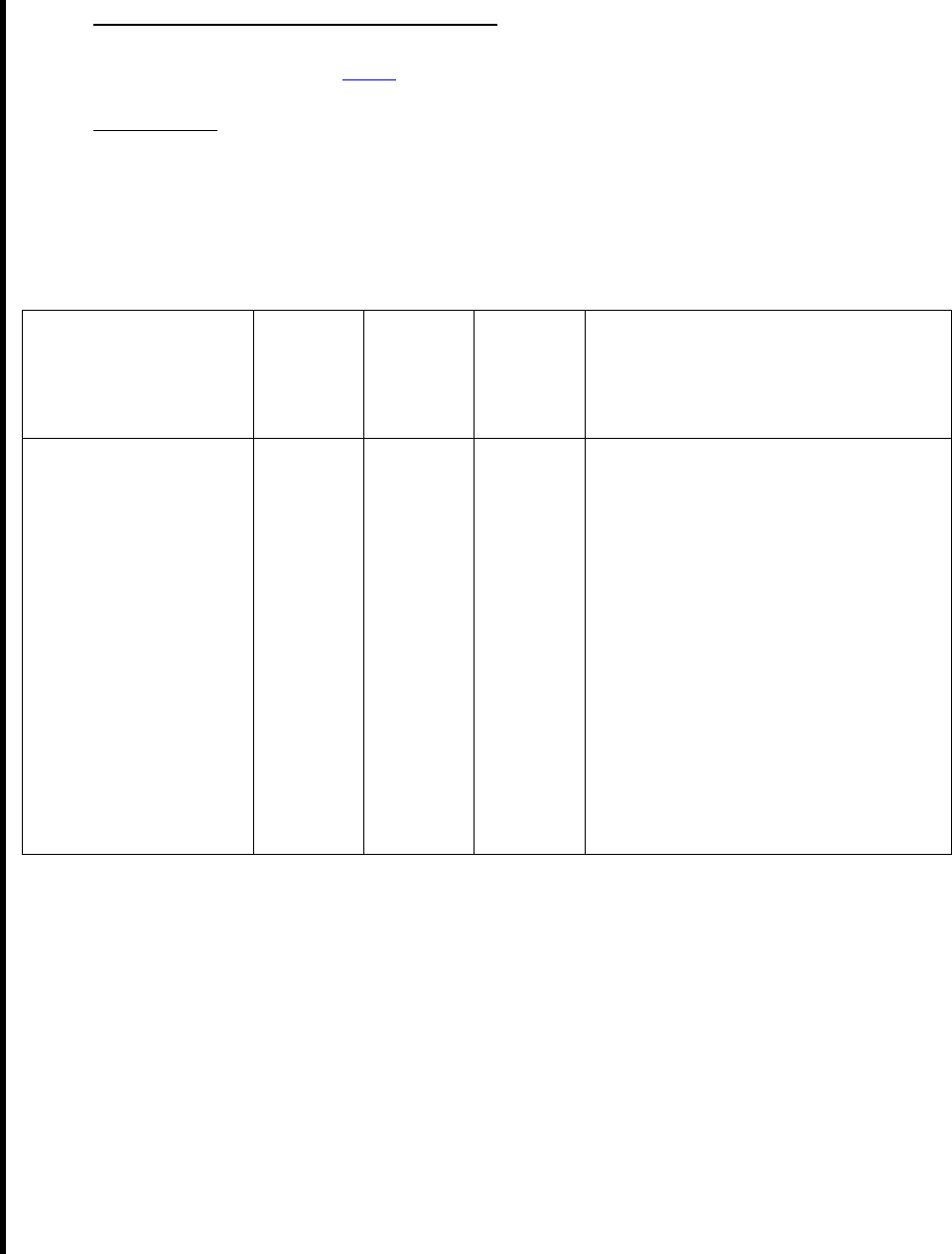
DATE “DRAFT” AC 91-67A
11-4
11.6.8 Title 14 CFR Part 43, § 43.13 Compliance. Any portions of an NEF program that
reference maintenance or a maintenance procedure must comply with acceptable
practices, as set forth in § 43.13.
11.6.9 NEF Proviso. The following proviso to an NEF program (see Figure 11-1 below) is
included in the operator-developed MEL ATA/JASC chapter 25, or in the case of an
MMEL used as an MEL, included in the procedures document. The reference proviso
must be copied verbatim. However, as indicated in the proviso, the aircraft operator’s
manual where the NEF program is found will contain specific processes and procedures.
Figure 11-1. Required NEF MEL Proviso for an Operator’s NEF Program
System & Sequence
Numbers
25 Equipment/
Furnishings
Repair
Interval
Number
Installed
Number
Required
for
Dispatch
Remarks or Exceptions
Nonessential
Equipment and
Furnishings (NEF)
-
-
0
May be inoperative, damaged, or
missing provided that the item(s) is
deferred in accordance with the NEF
deferral program. The NEF program,
procedures, and processes are
outlined in the operator’s [insert
name] Manual. (M) and (O)
procedures, if required, must be
available to the flightcrew and
included in the aircraft operator’s
appropriate document.
NOTE: Exterior lavatory door
ash trays are not considered NEF
items.
11.7 NEF Program Approval. An operator is not required to submit their NEF program, or
NEF program revisions, to the FAA, and the FAA is not required to review it. However,
the FAA may conduct surveillance on an operator’s NEF program at any time.
11.8 Criteria for Selection of NEF Items. NEF items are not safety-of-flight items. They
have not been evaluated by the FAA through the normal AED review process. Therefore,
before an operator can list an item as being deferrable under the NEF program, they will
follow their NEF program procedures. When reviewing items for inclusion in an
operator’s NEF item list, operators should ask the following questions:
• Is the item required for the operational rules in which the aircraft is operated?
• Does the item create the potential for fire/smoke or other hazardous condition?
• Could the item have an adverse effect on other required systems or components?

DATE “DRAFT” AC 91-67A
11-5
• Does the item’s condition potentially affect the safety of passengers, crew, or service
personnel?
• Could the item have a negative impact on emergency or abnormal procedures?
• Does the item create an additional workload for the crew at critical times of flight or
flight preparation?
• Does the flightcrew need to evaluate the deferred NEF item on a flight-by-flight
basis?
11.9 NEF Deferral Process. See Figure 11-2 for a flowchart that includes the following
elements in sequence. The flowchart is a guide for developing an NEF deferral process.
The process may be modified to facilitate inclusion in an operator’s overall MEL deferral
program with the intent of the elements outlined in the flowchart below being addressed.
11.9.1 Documentation. For an inoperative, damaged, or missing item to be considered for
inclusion in an NEF program, the discrepancy will be documented in the aircraft logbook
(or other approved location) per the operator’s discrepancy reporting system. This action
is completed by the flightcrew, company maintenance personnel, or personnel authorized
and approved to perform such functions as outlined in the operator’s maintenance
program.
11.9.2 Current NEF Items. If the inoperative, damaged, or missing item is already on the NEF
item list (if used), the established procedures for NEF deferral of the item will be
followed.
11.9.3 MMEL, CDL, or MEL Items. An MMEL, CDL, or MEL item may not be deferred in
accordance with the operator’s NEF program. The operator must follow the deferral
procedures for inoperative, damaged, or missing items listed in the MMEL, MEL, or
CDL, as per § 91.213(a)(5).
11.9.4 Subcomponents of MMEL, CDL, or MEL Items. If the inoperative, damaged, or missing
item is a subcomponent of a system identified in the MMEL/MEL/CDL, where no
previous relief was authorized, the subcomponent may not be deferred in accordance with
the operator’s NEF program.
11.9.5 Required by Certification or Operational Rules. If the item is required by any applicable
certification or operational rules, the item may not be deferred in accordance with the
operator’s NEF program.
11.9.6 Safety-of-Flight Issues. If it is evident from a maintenance or operational perspective that
an item could have an adverse effect on safety of flight; or if there is a safety of flight
issue with an inoperative, damaged, or missing item, that item may not be deferred.
11.9.7 Source (Underlying Cause). If the presence of a safety-of-flight issue is unknown, not
present, or not applicable, ascertain whether the source or root cause for the item can be
identified. If the source or root cause cannot be identified or isolated, that item may not
be deferred in accordance with the operator’s NEF program.

DATE “DRAFT” AC 91-67A
11-6
11.9.8 Effects on Equivalent Level of Safety (ELOS). If the item has no impact on safety of
flight, that item may be deferred in accordance with the operator’s NEF program.
11.9.9 Isolated with Applicable Maintenance Procedures. If the item can be isolated and
re-evaluated using applicable maintenance procedures and a determination made that
there is no safety of flight concern, it may be deferred in accordance with the operator’s
NEF program.
11.9.10 Defer in Accordance with the Operator’s NEF Program.
11.9.11 Update the NEF Item List, as Required.
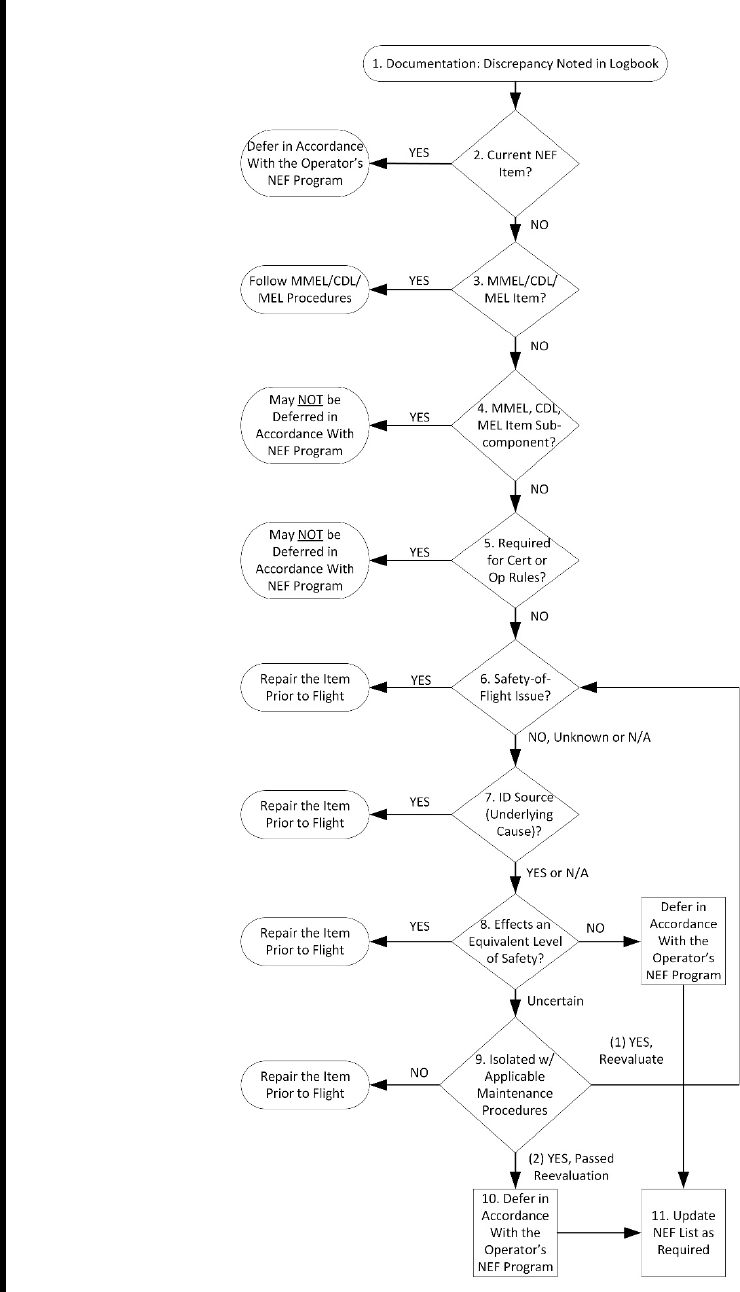
DATE “DRAFT” AC 91-67A
11-7
Figure 11-2. NEF Item Selection Criteria Elements Flowchart

DATE “DRAFT” AC 91-67A
12-1
CHAPTER 12. CONFIGURATION DEVIATION LIST (CDL)
12.1 Purpose of the CDL. The CDL is a list of externally exposed nonstructural aircraft parts
that may be missing and is tailored for each model aircraft. The CDL evolved over
several years from what was commonly known as a “missing parts list,” which was a list
of nonstructural external parts of an aircraft that were found missing after flight. The
missing parts list is known today as the CDL. A CDL allows continued operation with
missing externally exposed nonstructural parts by defining restrictions, limitations, or
performance penalties, while the aircraft remains airworthy.
12.2 Development. The aircraft manufacturer develops a CDL during the initial certification
process. This is not a requirement for aircraft certification. The manufacturer makes the
decision to develop or not to develop a CDL. The responsible Aircraft Certification
Service office has final approval of all FAA-approved CDLs and all requests for
revisions to an FAA-approved CDL.
12.2.1 Which Aircraft Has a CDL. A CDL is developed for most U.S.-built transport category
part 25 aircraft and many part 23 aircraft by aircraft manufacturers during the initial
certification process. However, they are not a required element for aircraft certification.
The manufacturer makes the decision to develop or not to develop a CDL. If deemed
necessary, the aircraft manufacturer develops a proposed CDL and coordinates
submission with the responsible Aircraft Certification Service office and the AED. The
responsible Aircraft Certification Service office and AED review, evaluate, and may
conduct or oversee any required testing and data collection necessary to approve
proposed CDL items. Approval of a CDL is by the responsible Aircraft Certification
Service office or through an OEM Organization Designation Authorization (ODA)
program.
12.2.2 U.S.-Manufactured Aircraft. For U.S.-manufactured aircraft, an FAA-approved CDL is
either:
• Incorporated into the limitations section of the AFM,
• Published as an appendix to the AFM, or
• Published as a supplement to the AFM.
12.2.3 Aircraft Manufactured Outside the United States. The CDL may be a standalone
document that is part of the SRM or another manufacturer’s document.
12.3 CDL Versus MEL. An MEL and a CDL are separate documents. An MEL is approved
by the responsible Flight Standards office. A CDL is approved by the responsible Aircraft
Certification Service office, or through an OEM’s ODA program. An MEL and a CDL
may be kept in the same binder but will be clearly partitioned as two separate
“stand-alone” documents. If an operator desires an amendment to the CDL, the request
should be made to the responsible Aircraft Certification Service office, or directly to the
aircraft manufacturer.

DATE “DRAFT” AC 91-67A
12-2
12.4 CDL Management Program. Operators will ensure they comply with all penalties,
limitations, and restrictions associated with a CDL. An operator may develop procedures
more restrictive than the CDL. An operator is not required to have a CDL management
program. If an operator chooses to develop a CDL management program, they are not
required to submit it to the FAA, and the FAA is not required to review it.
